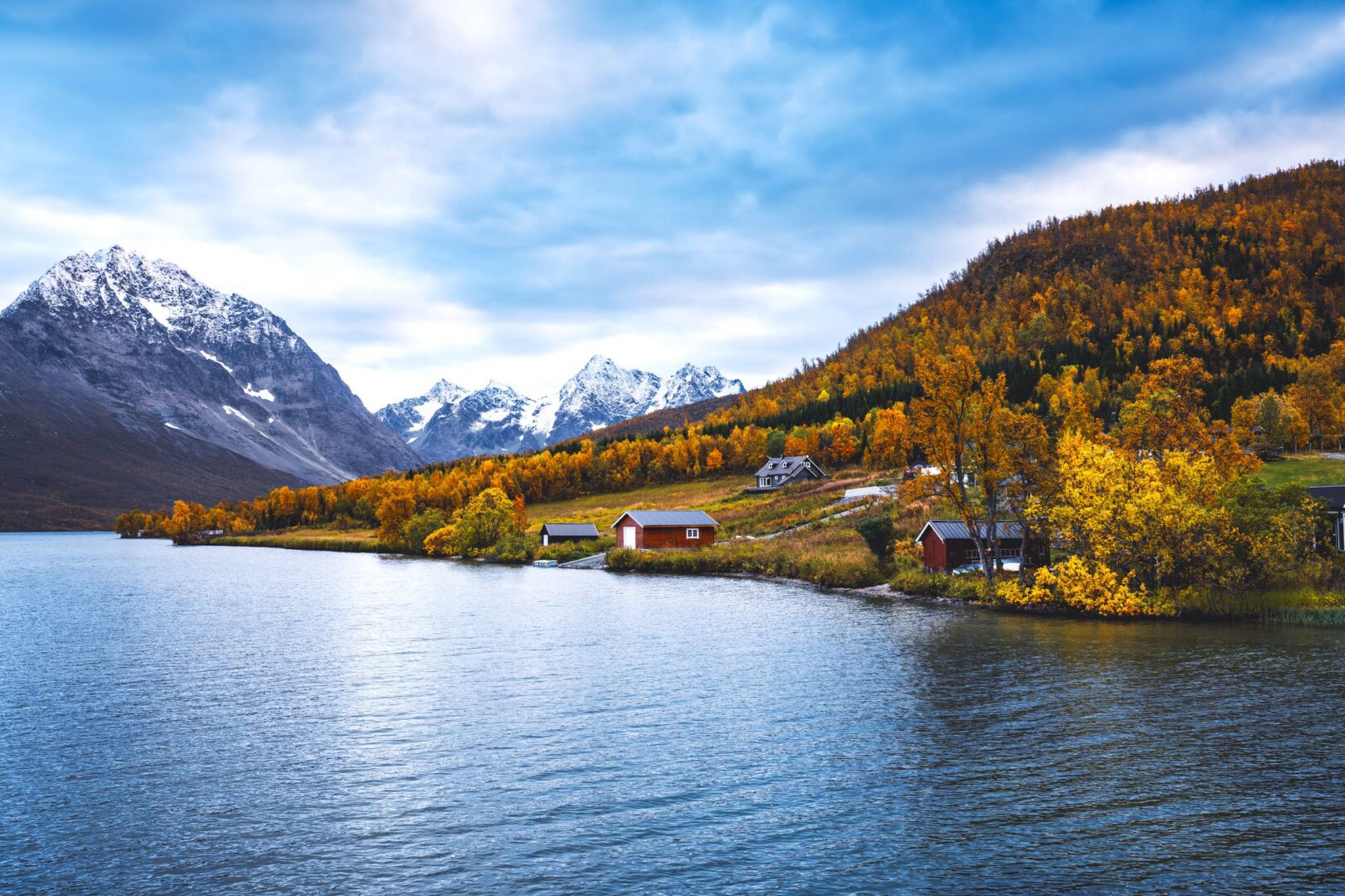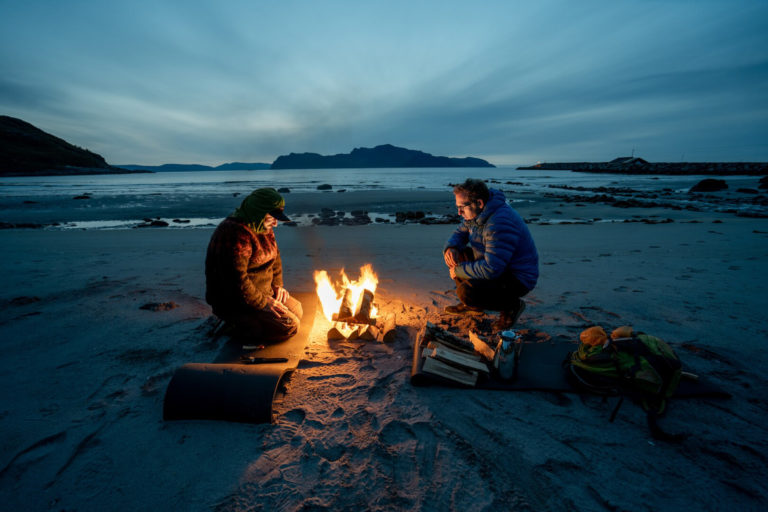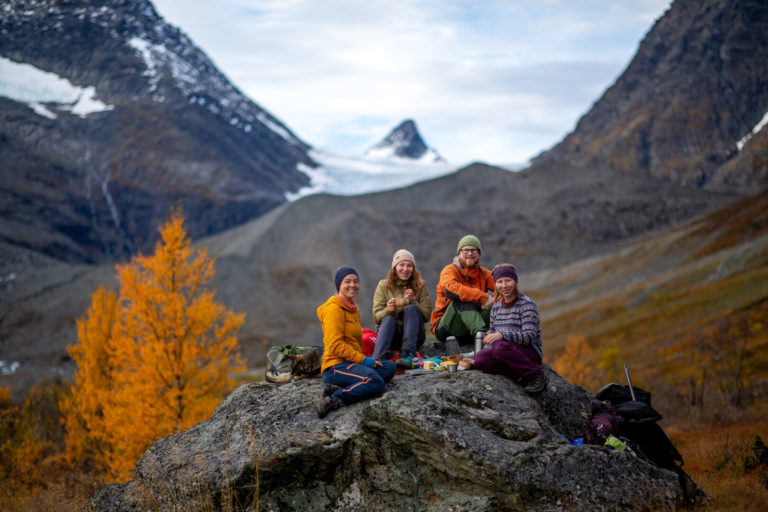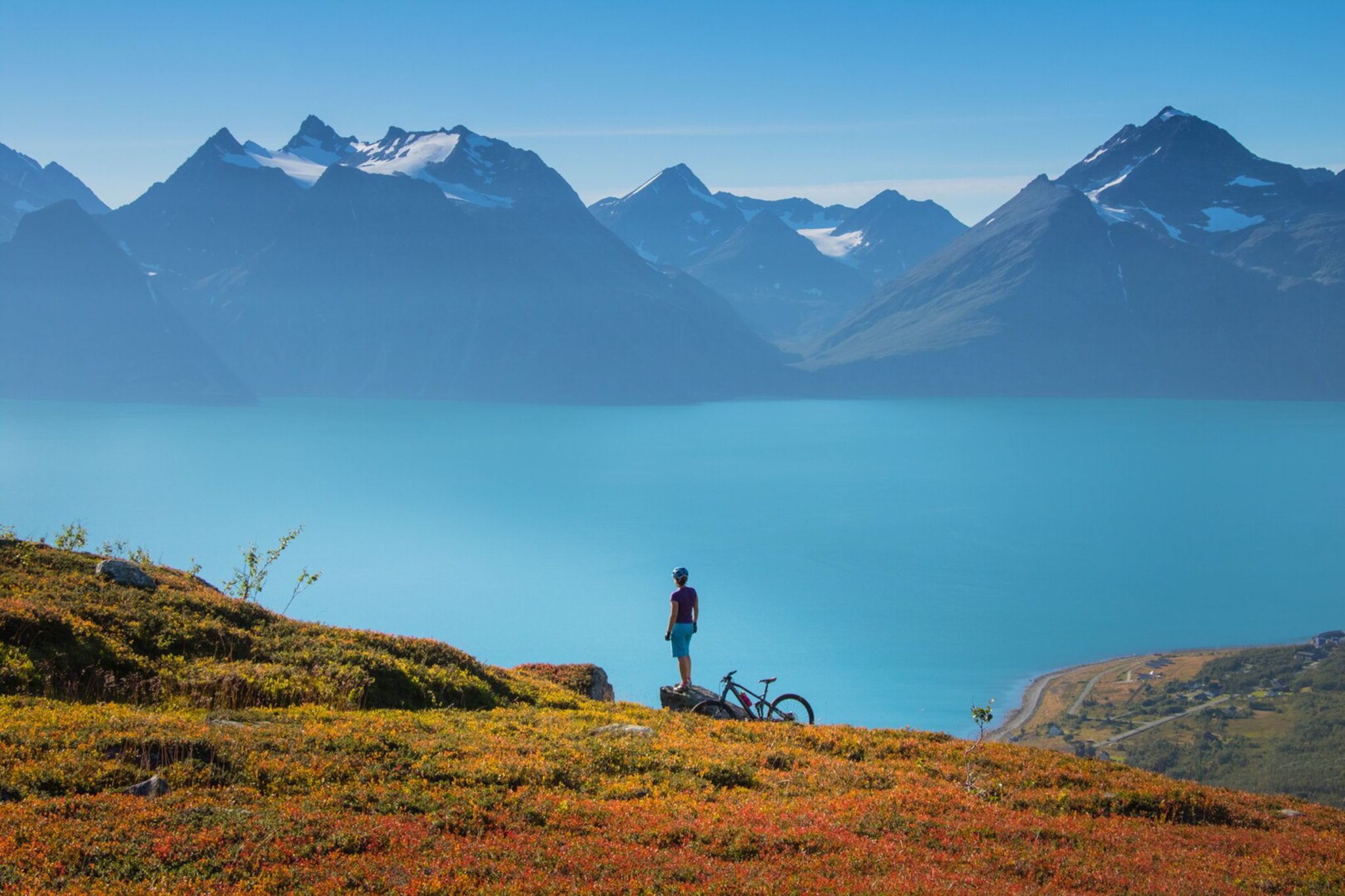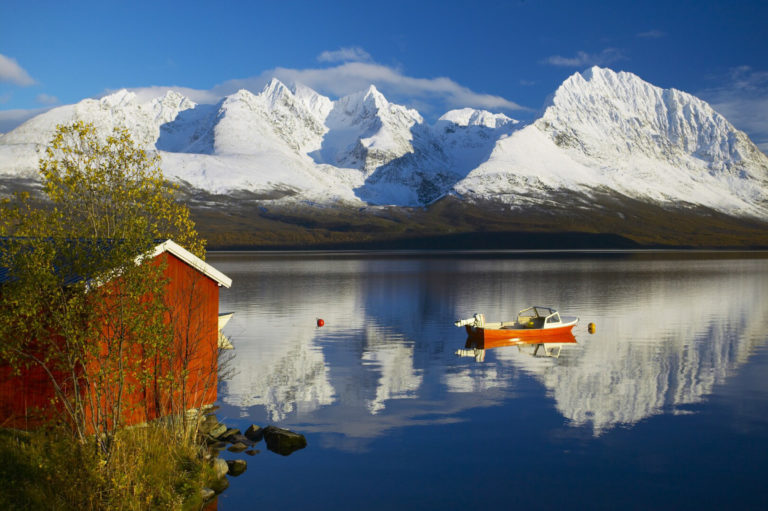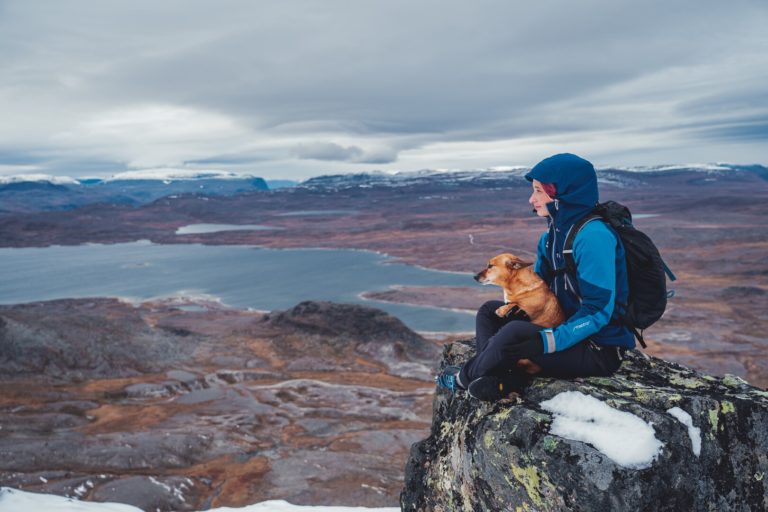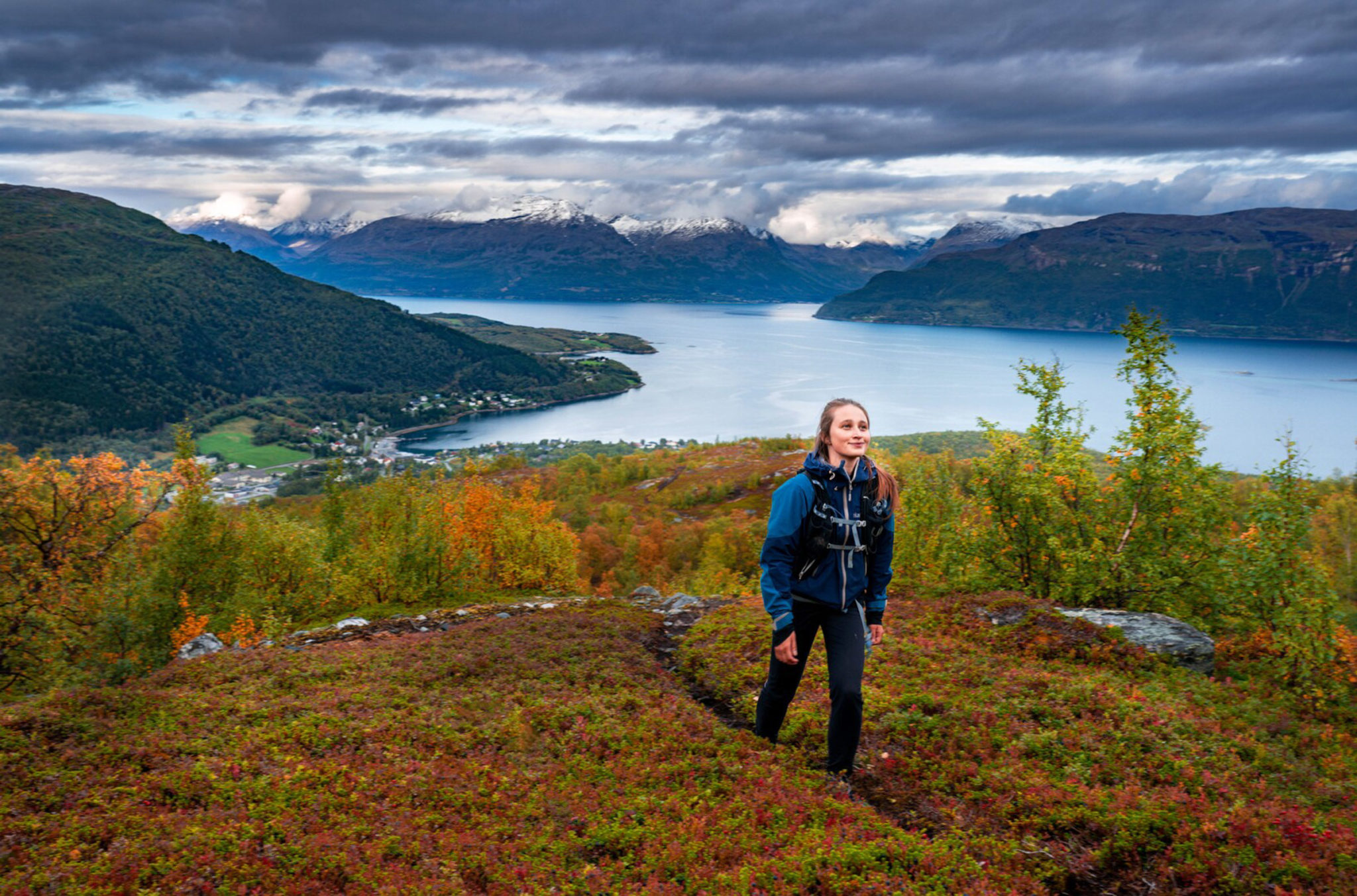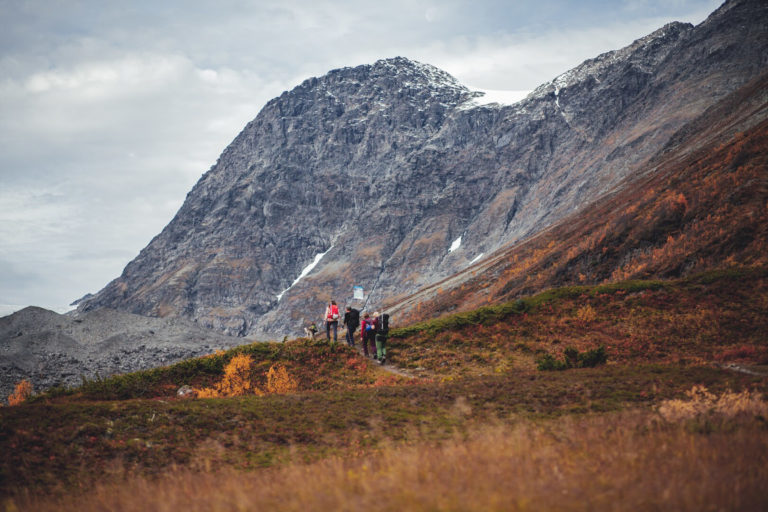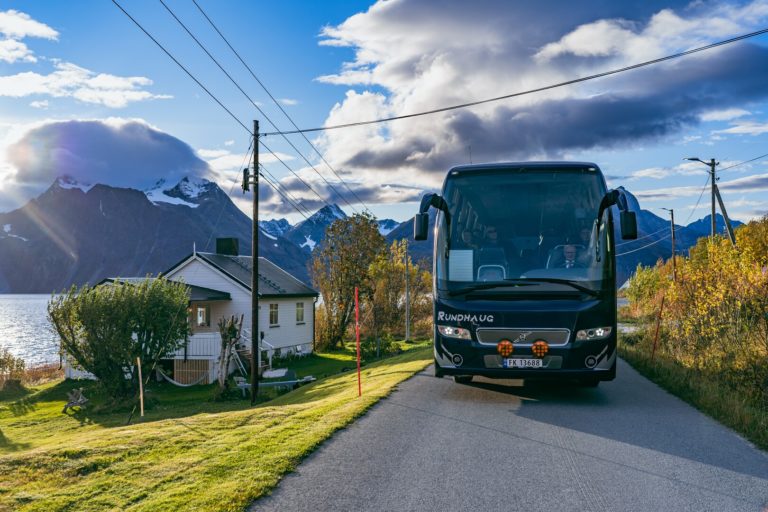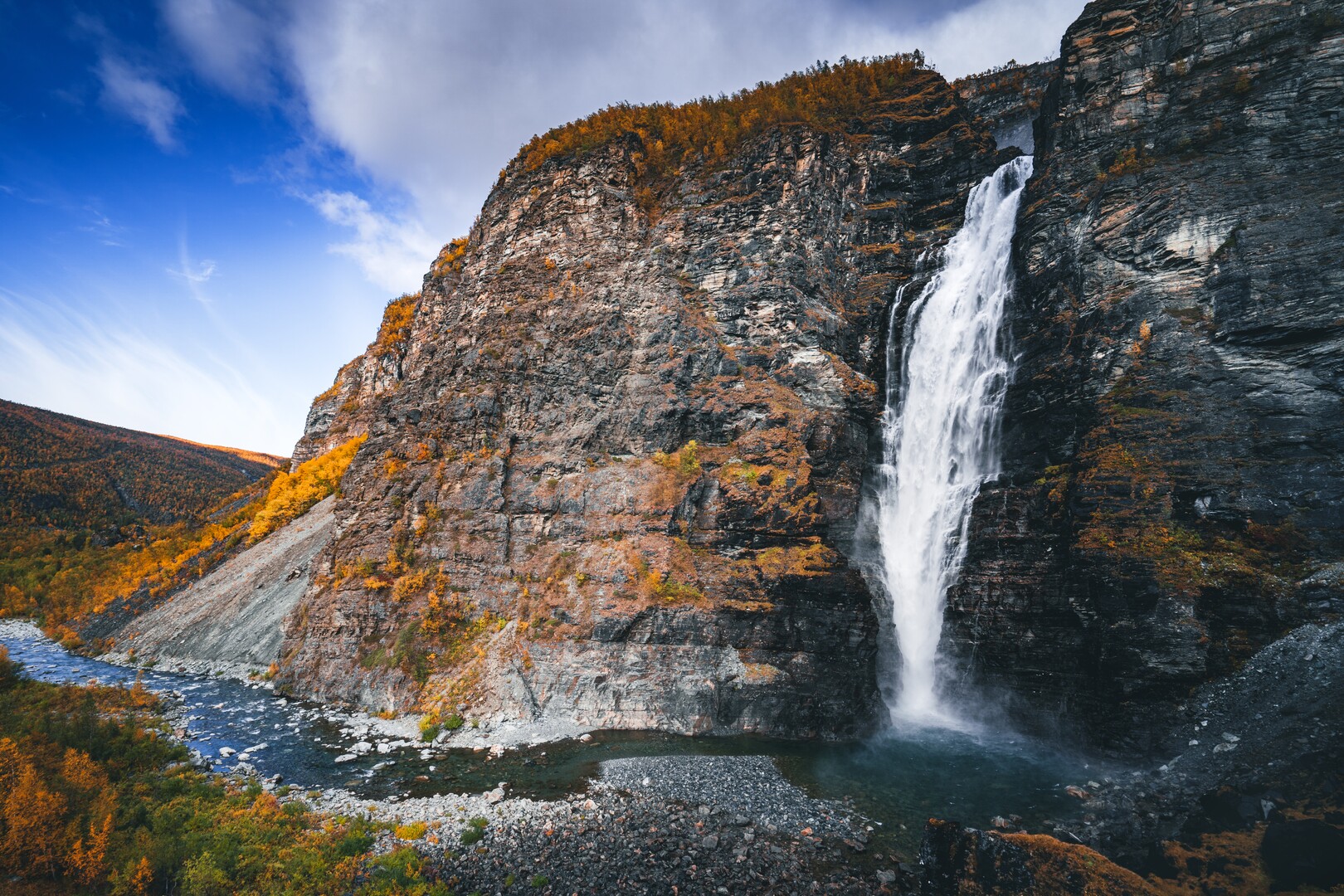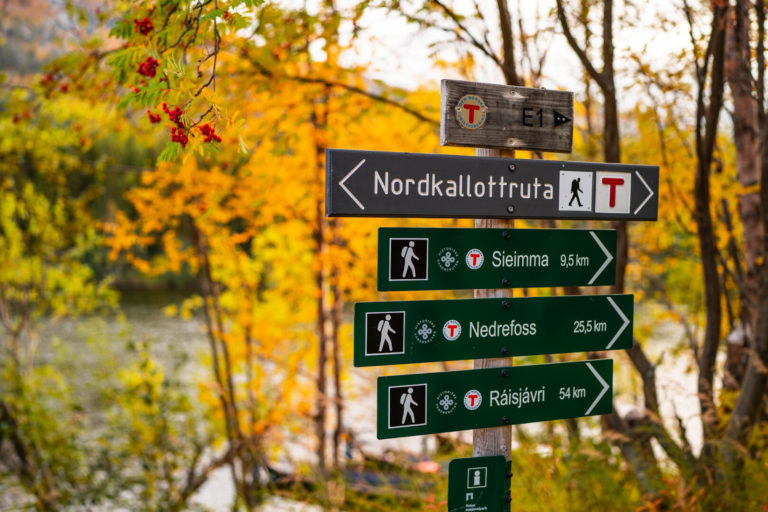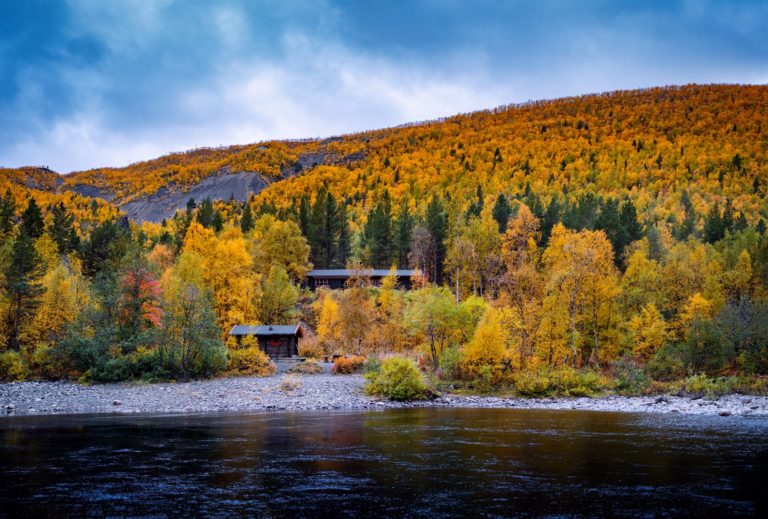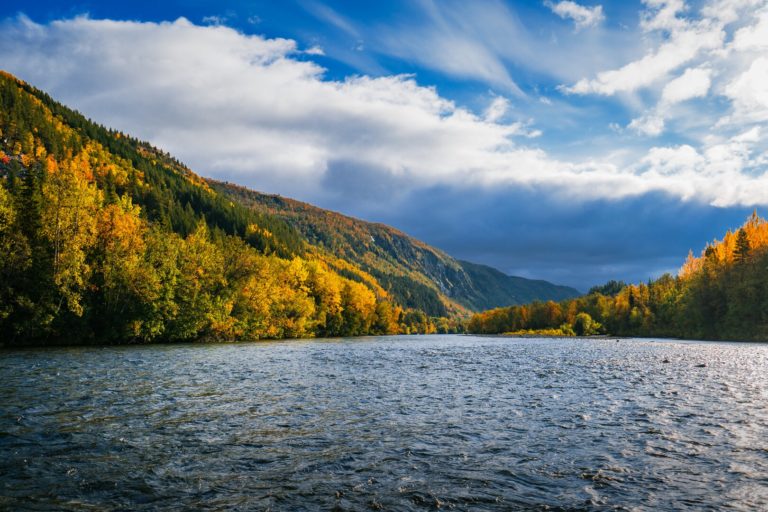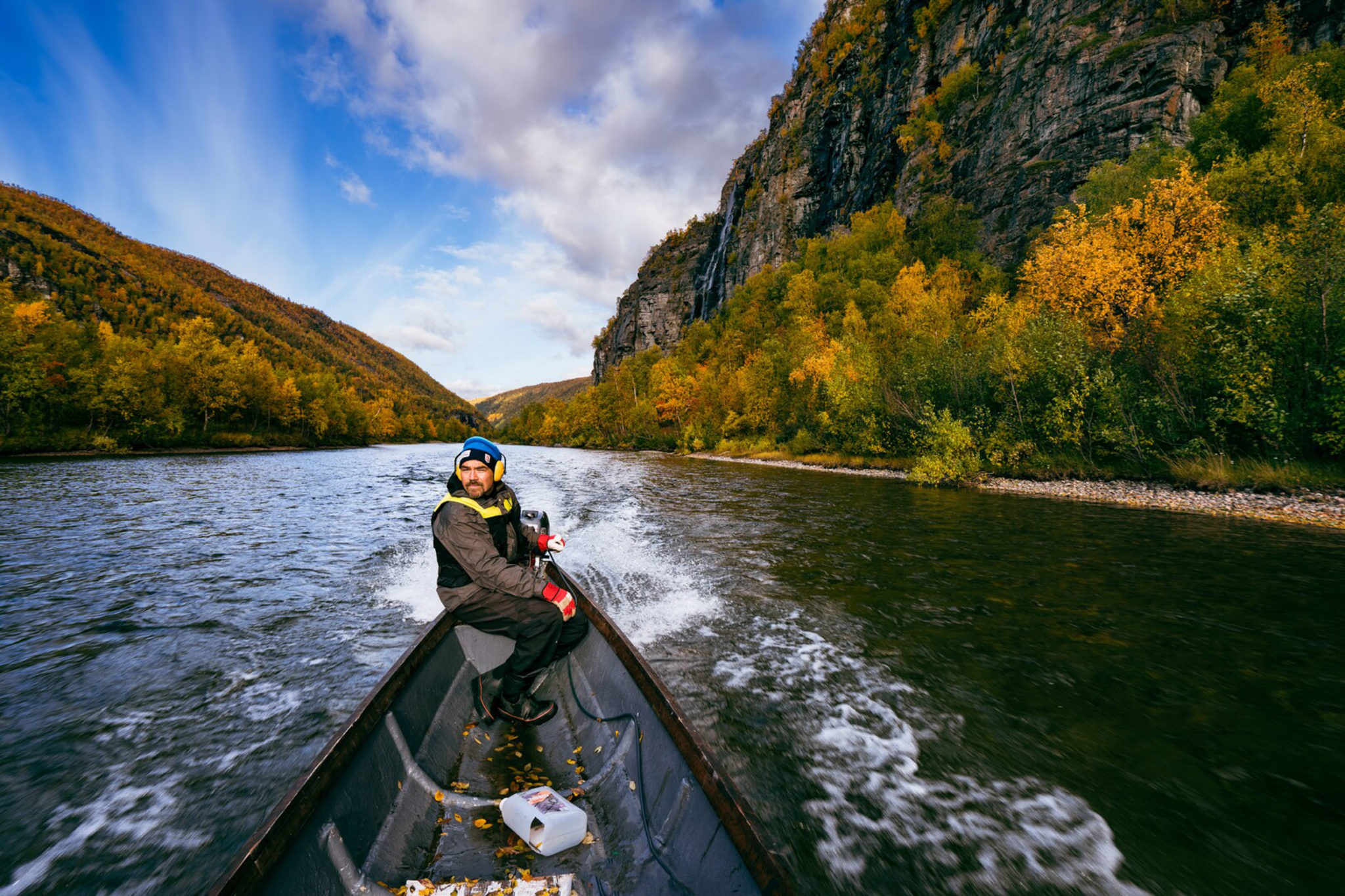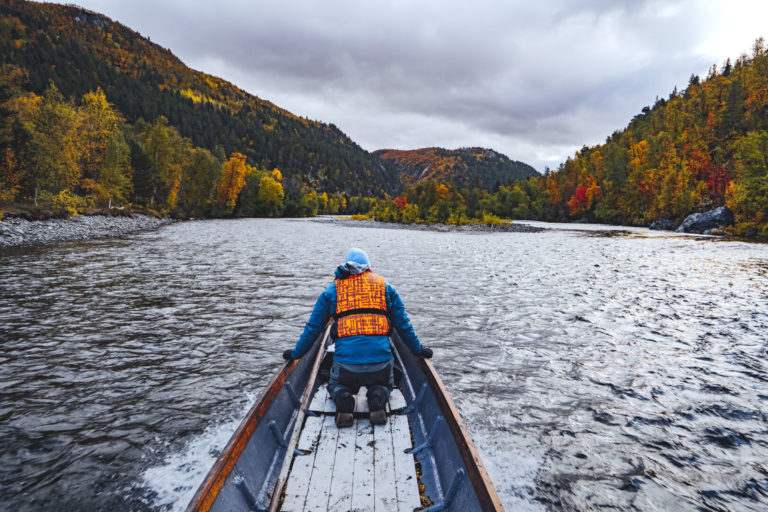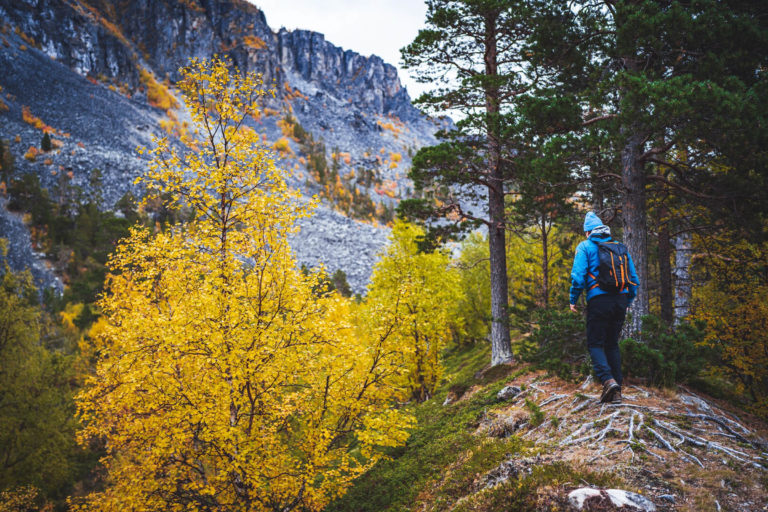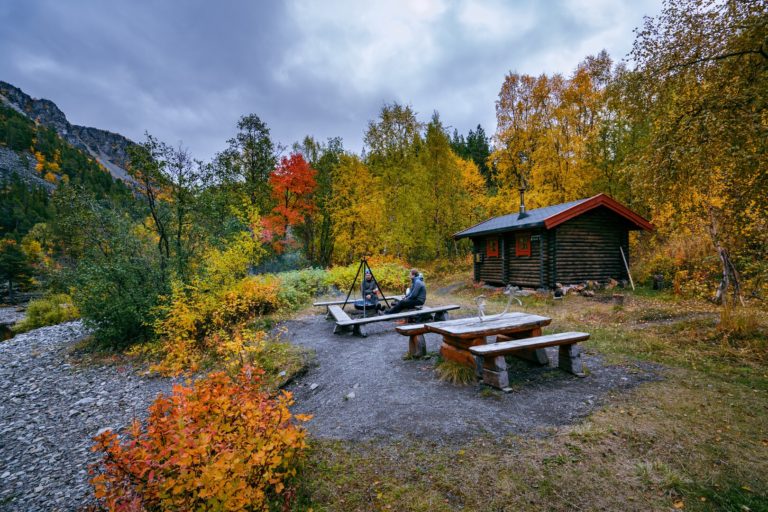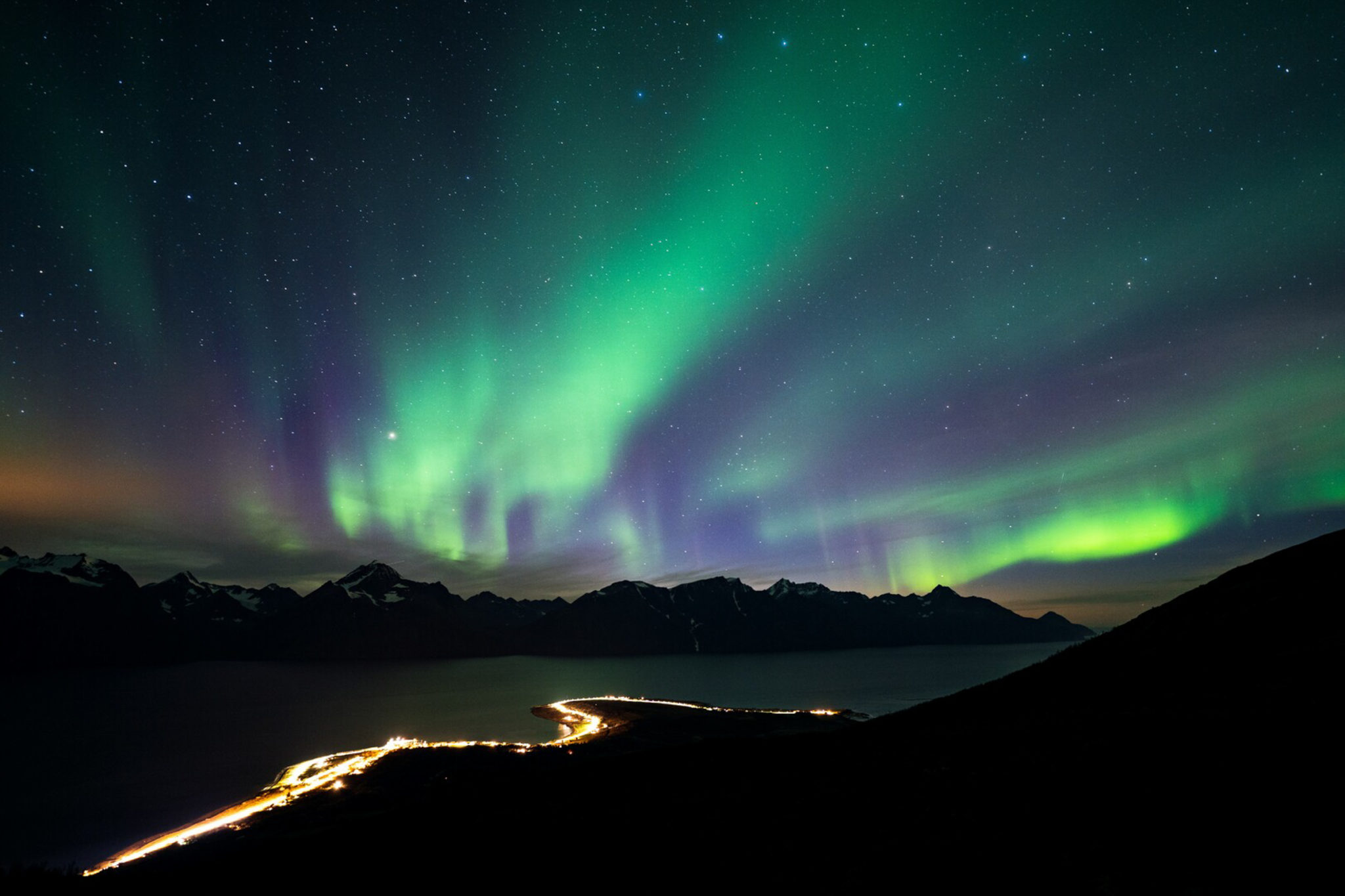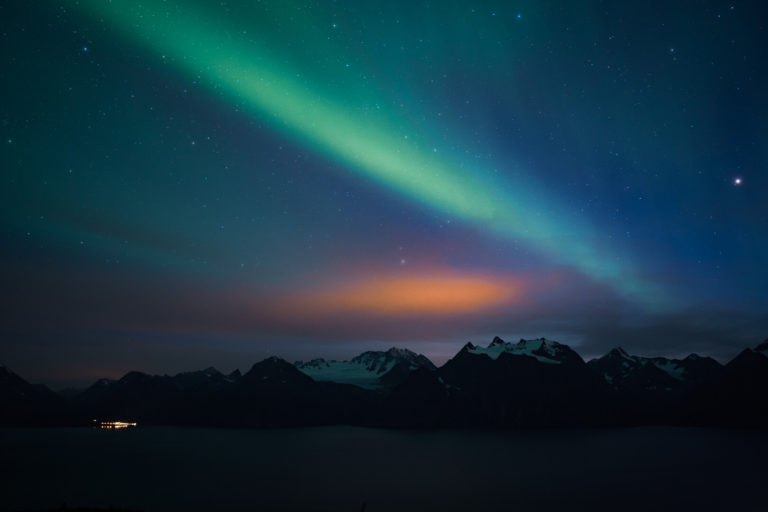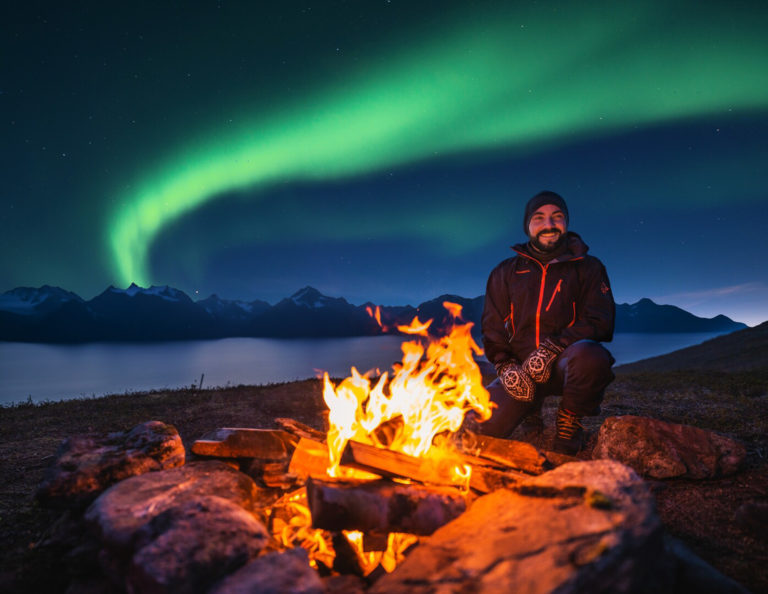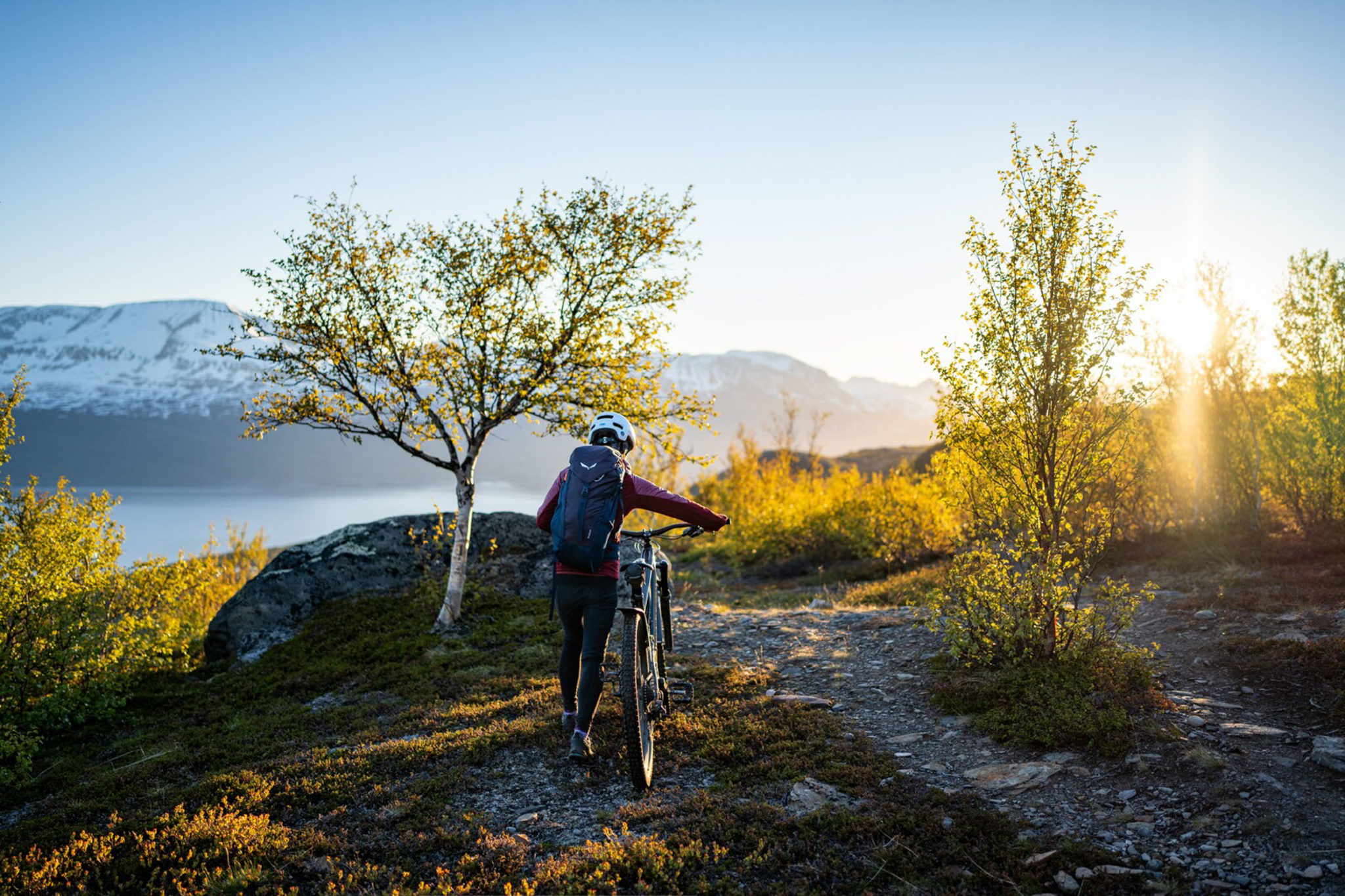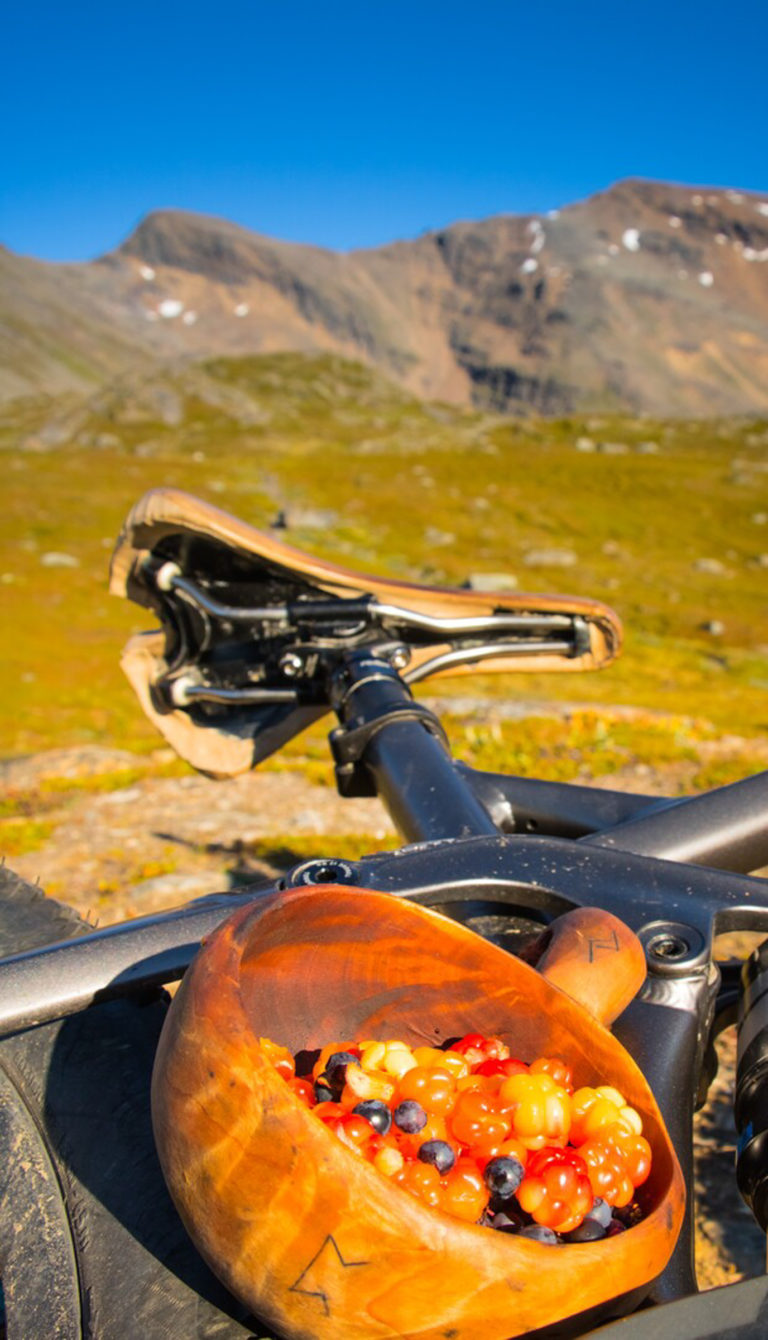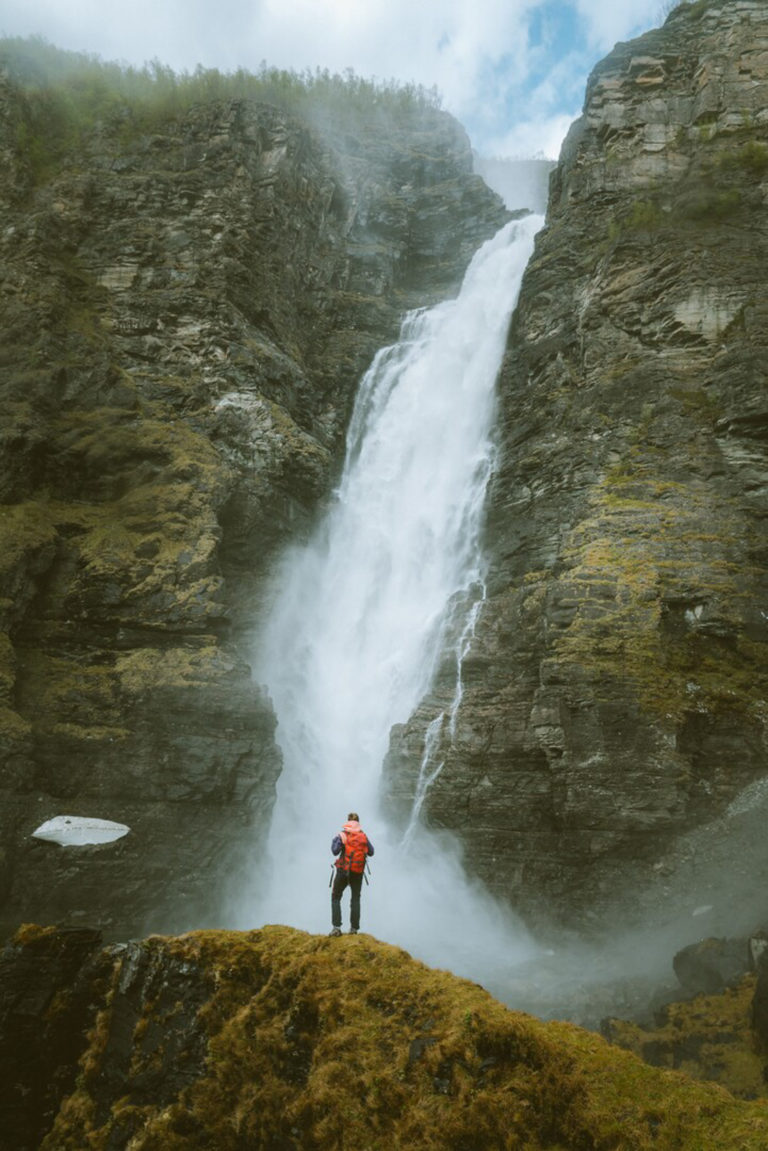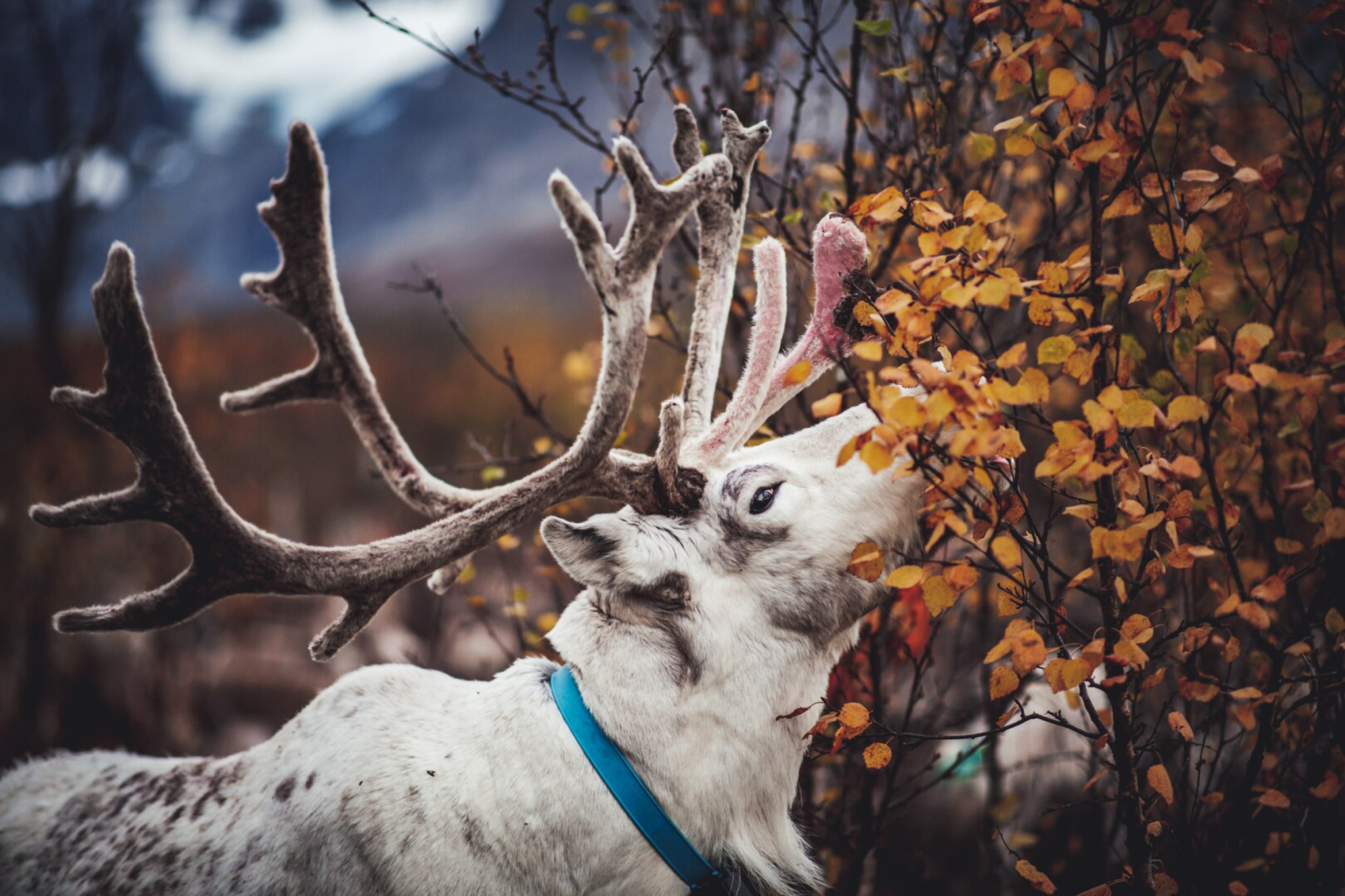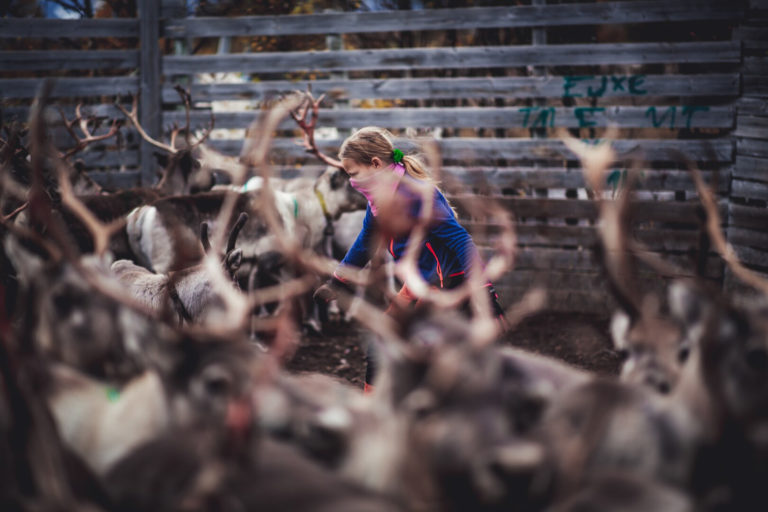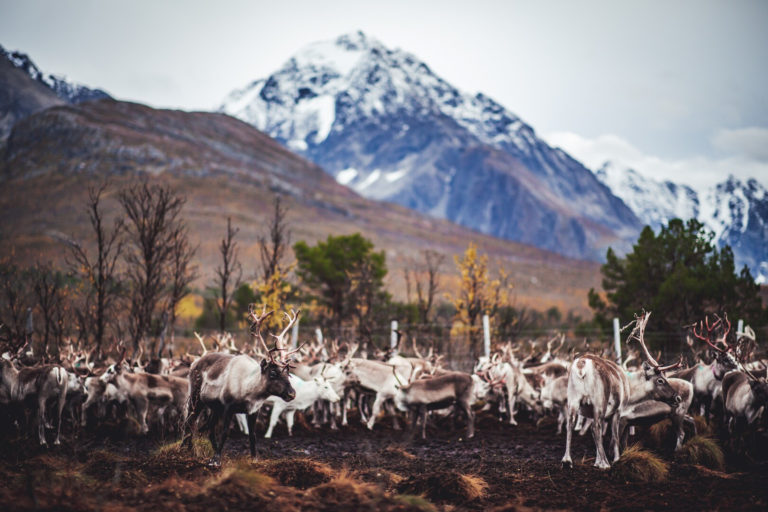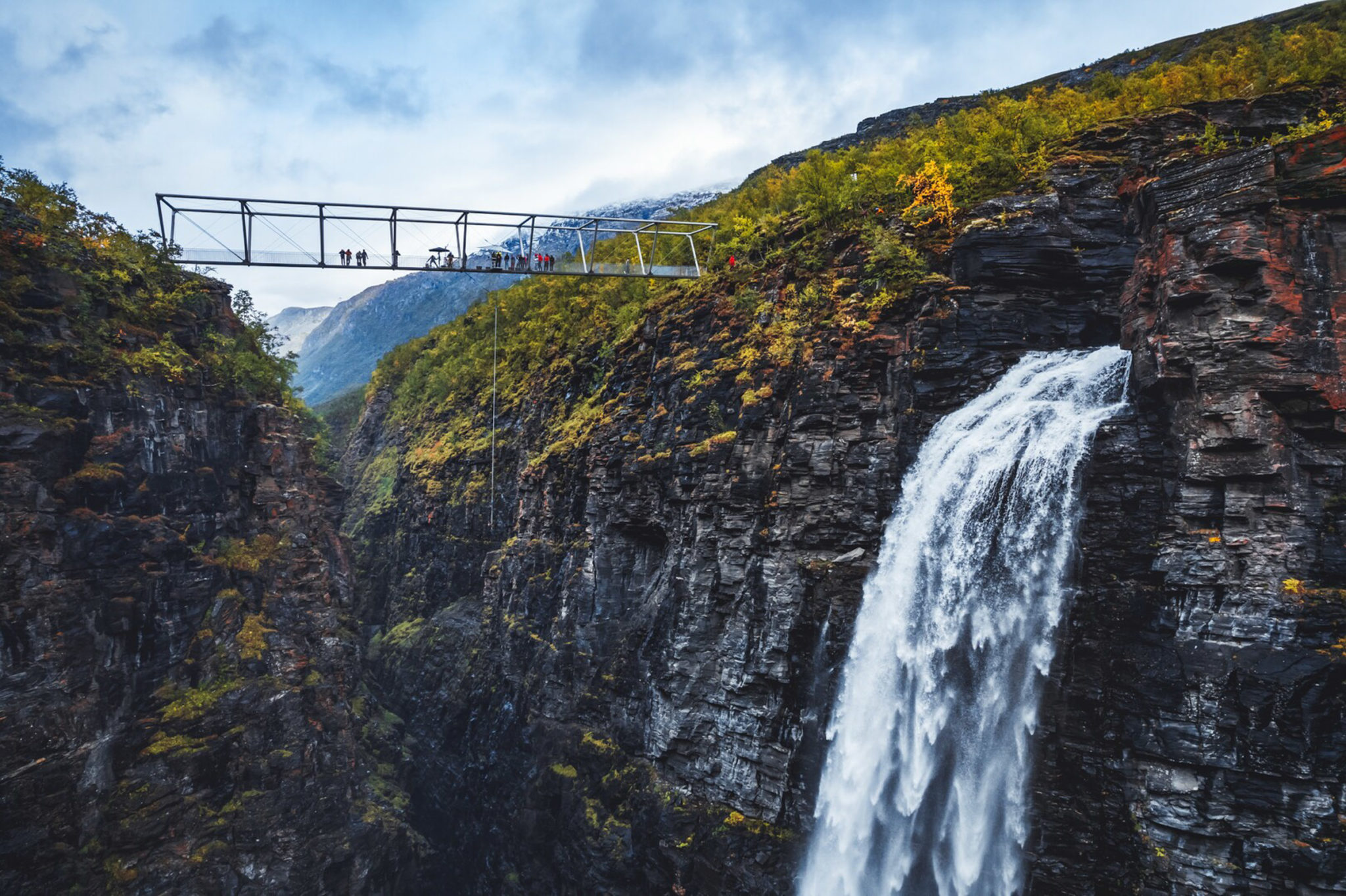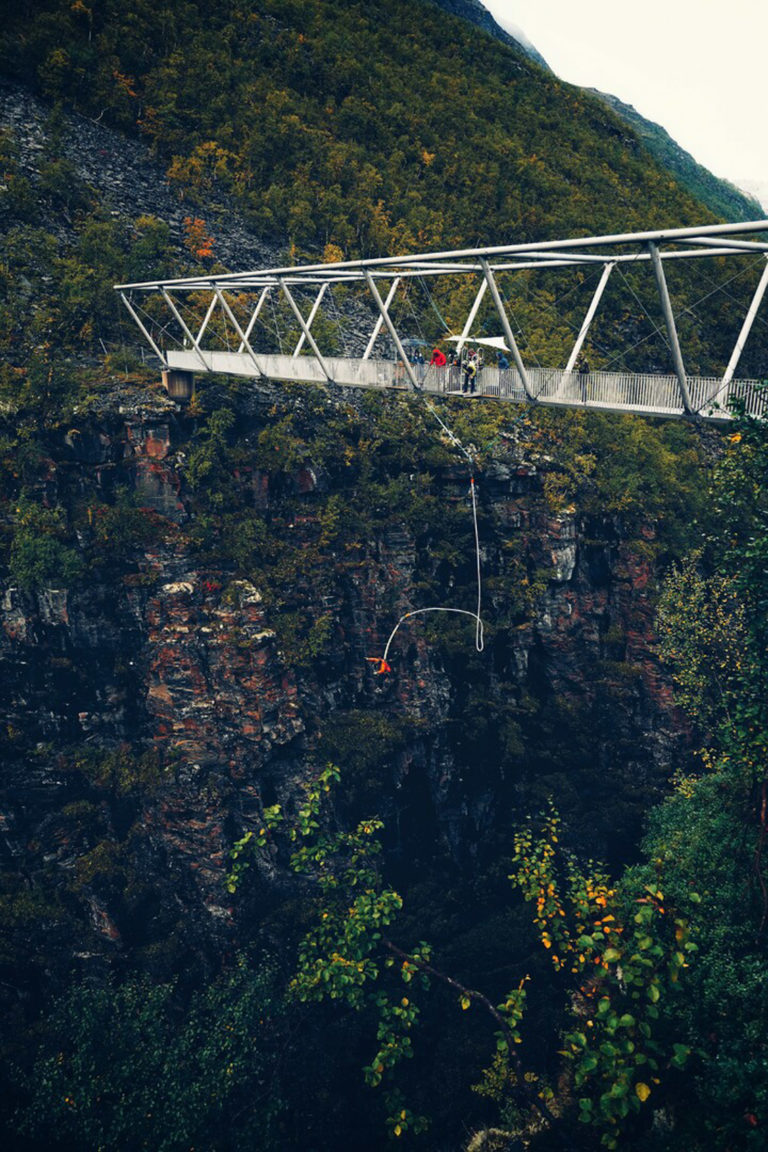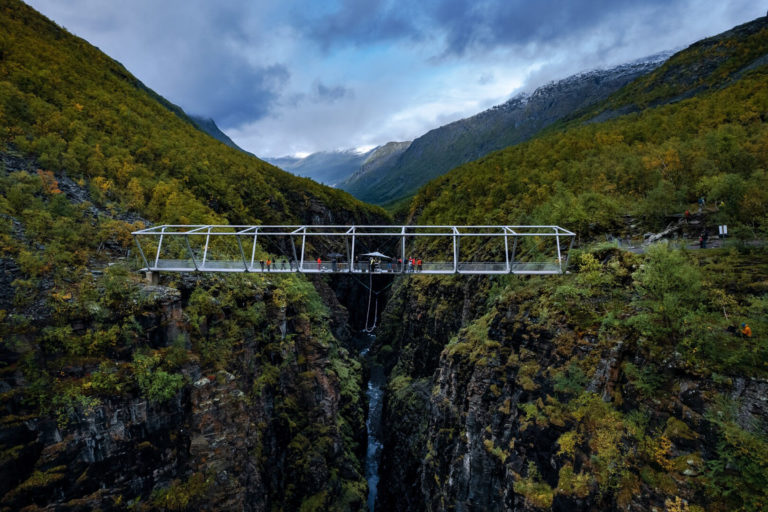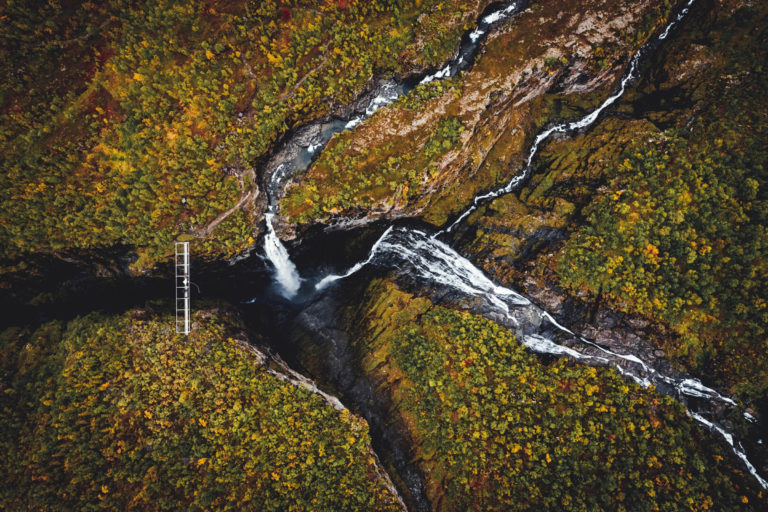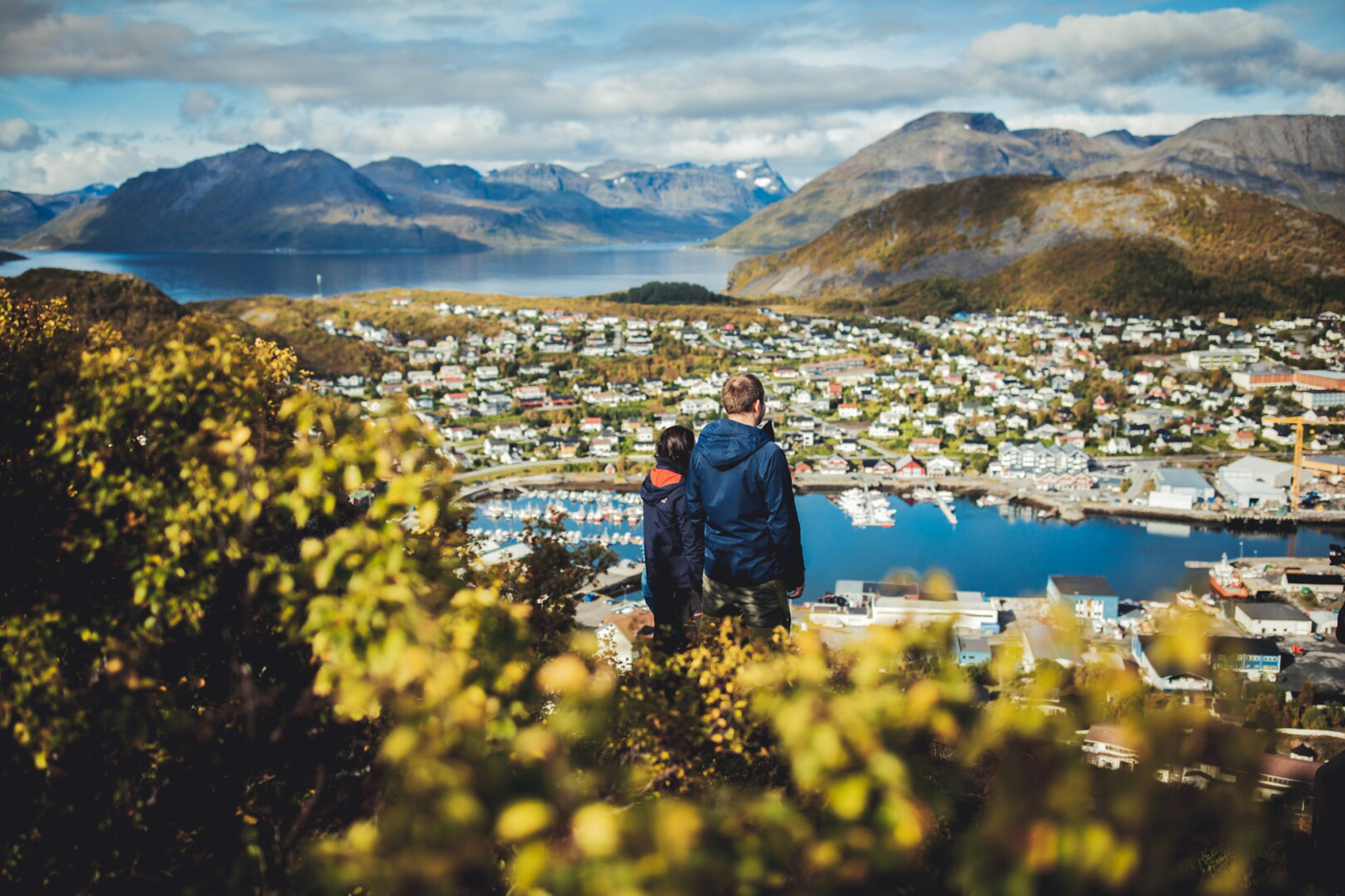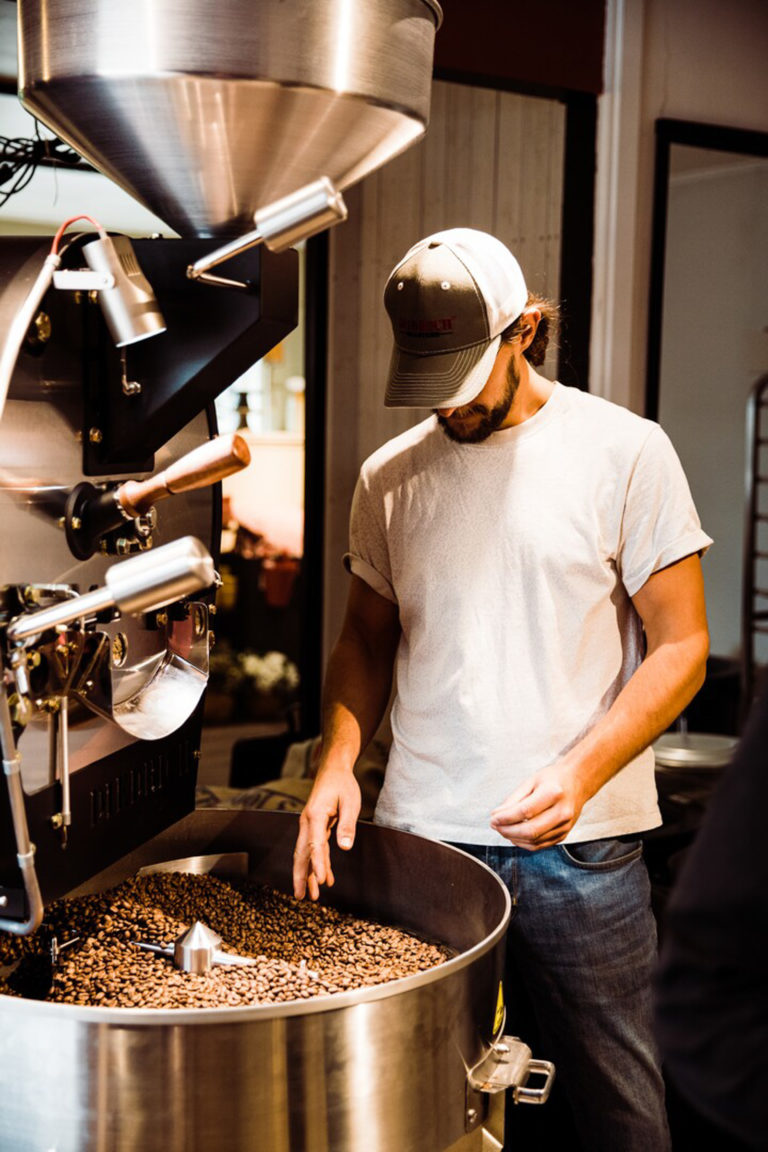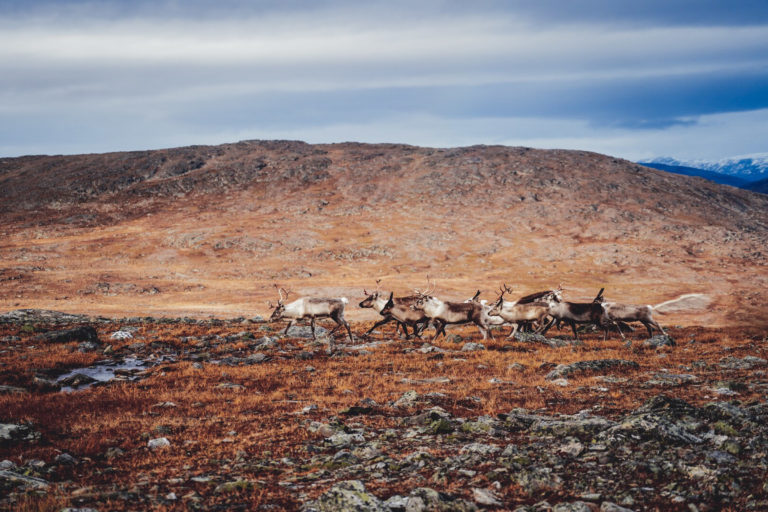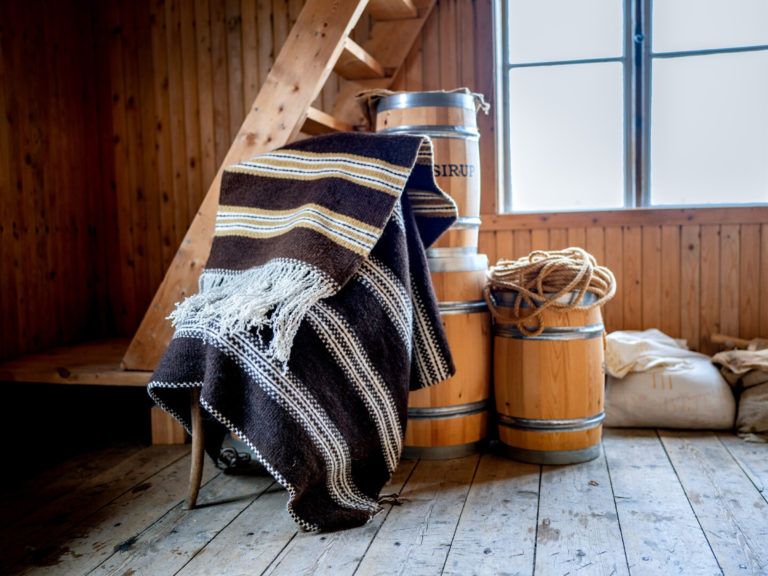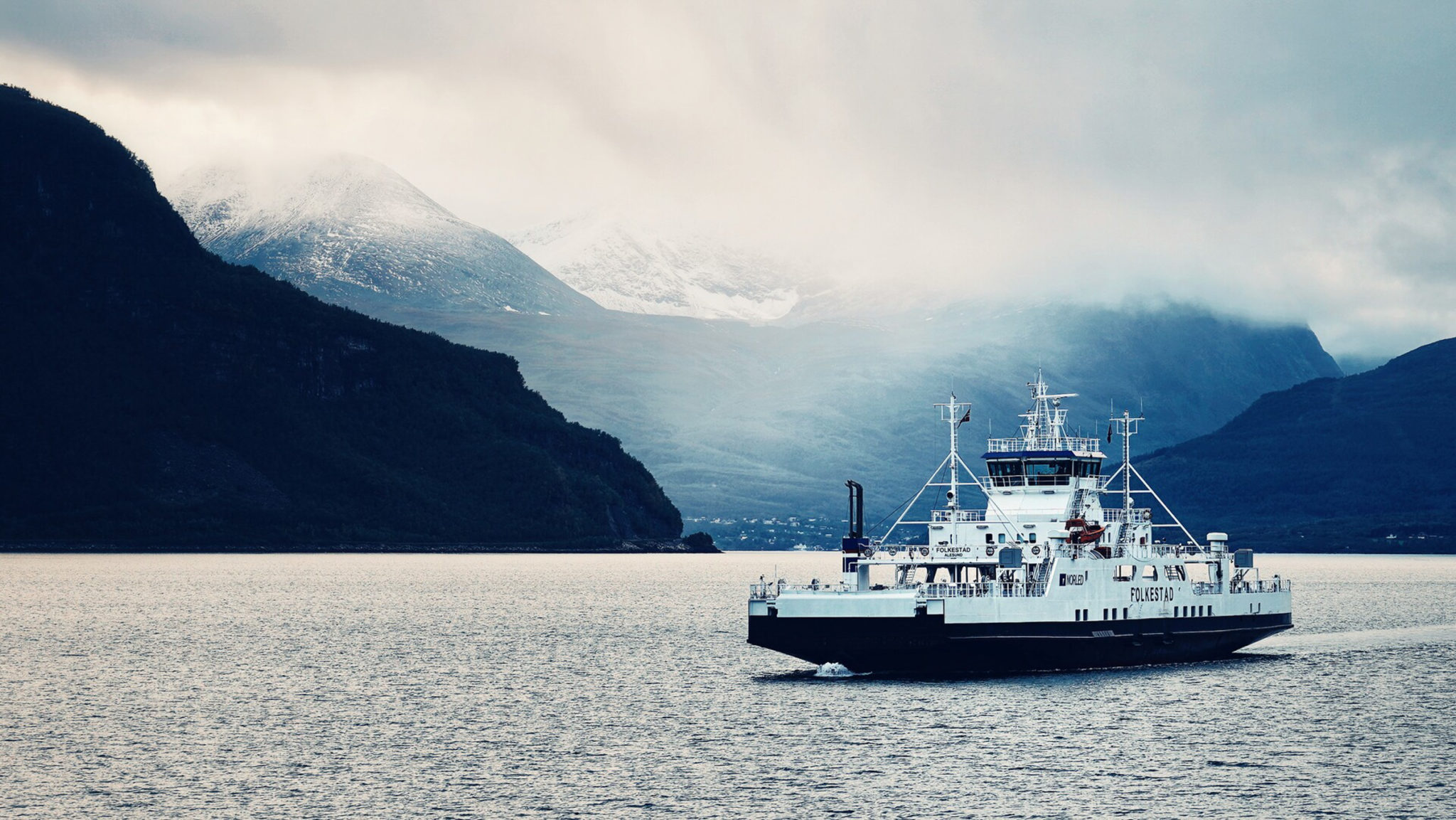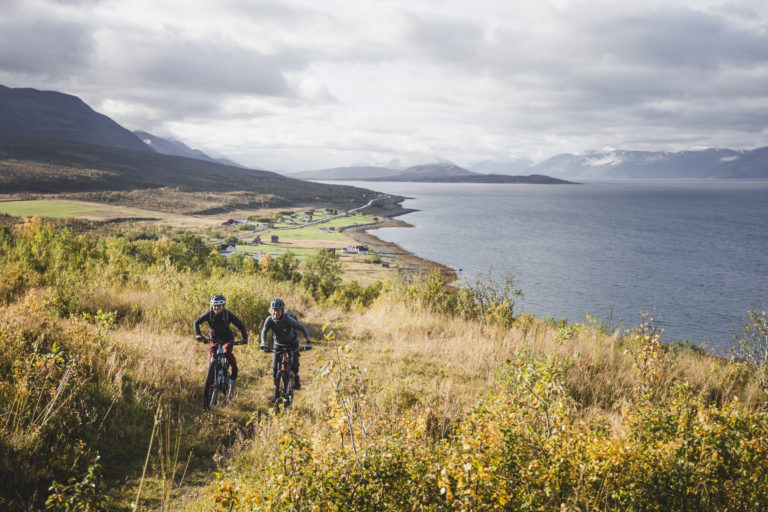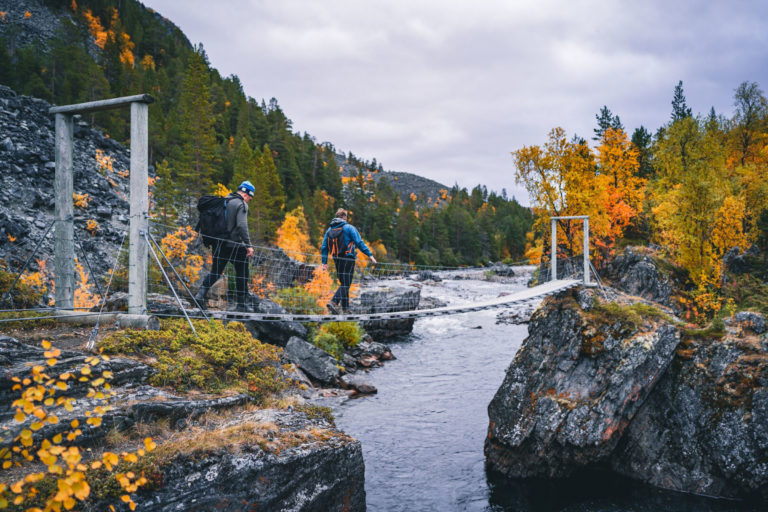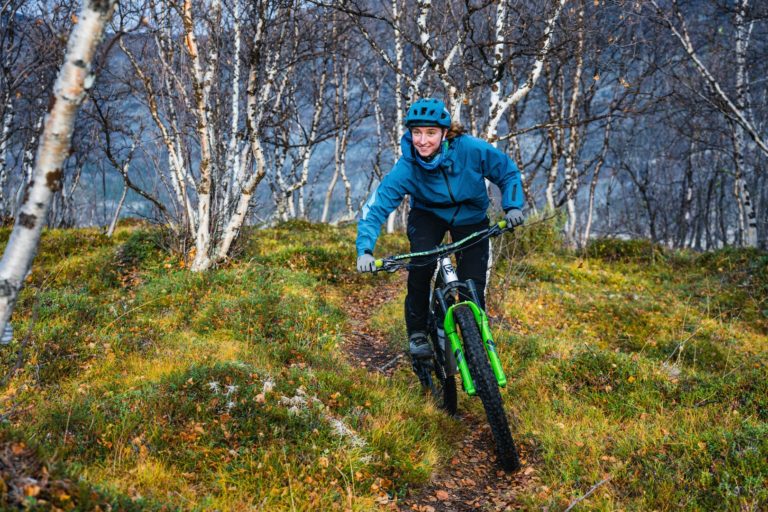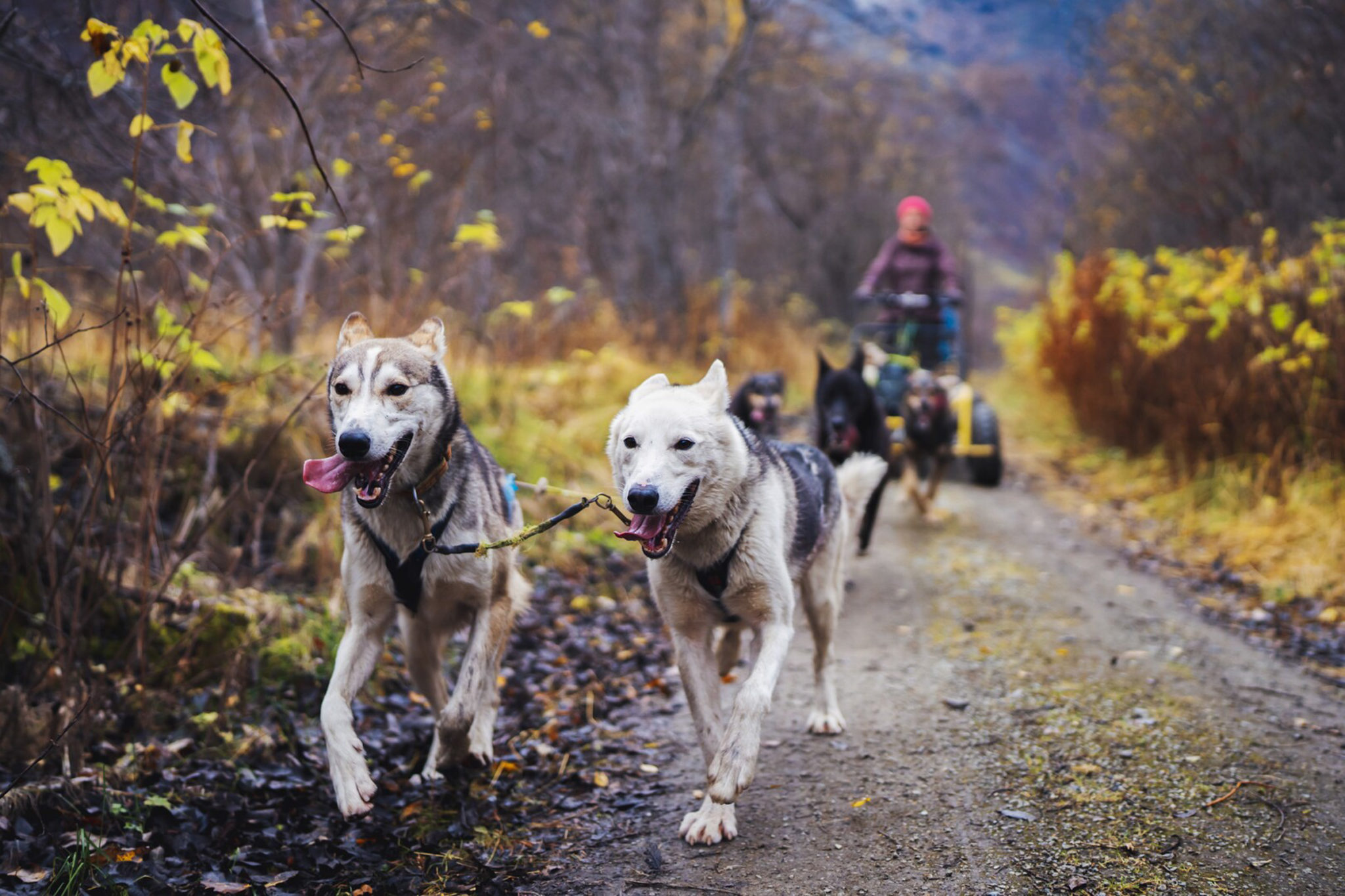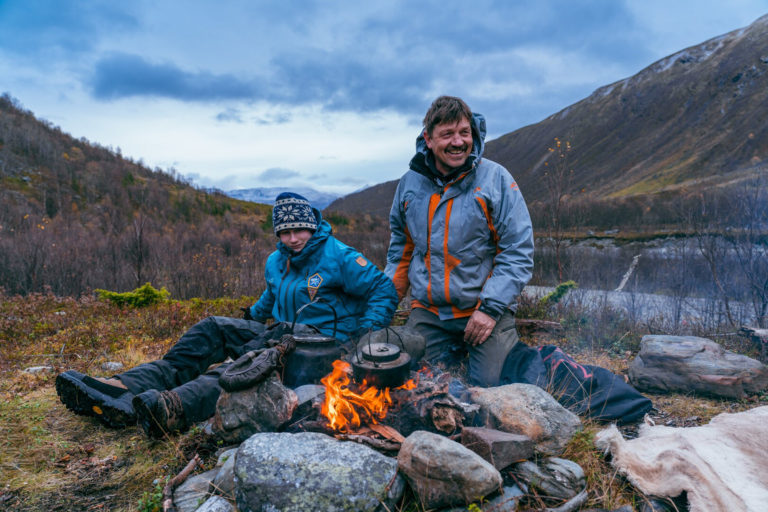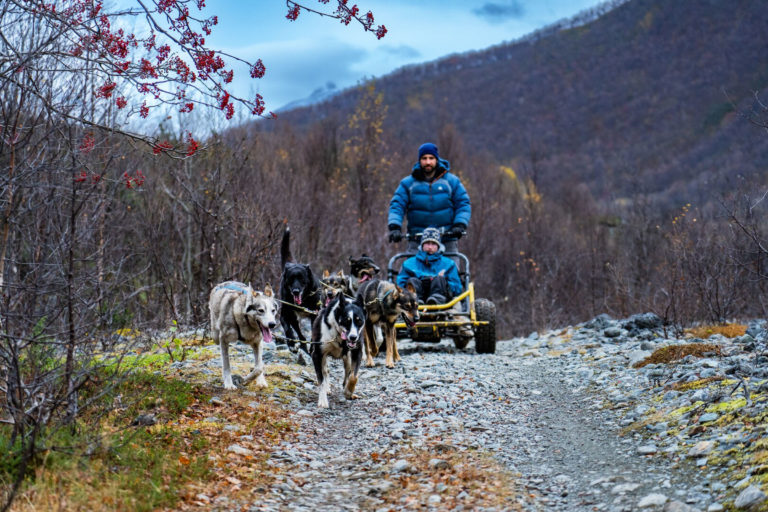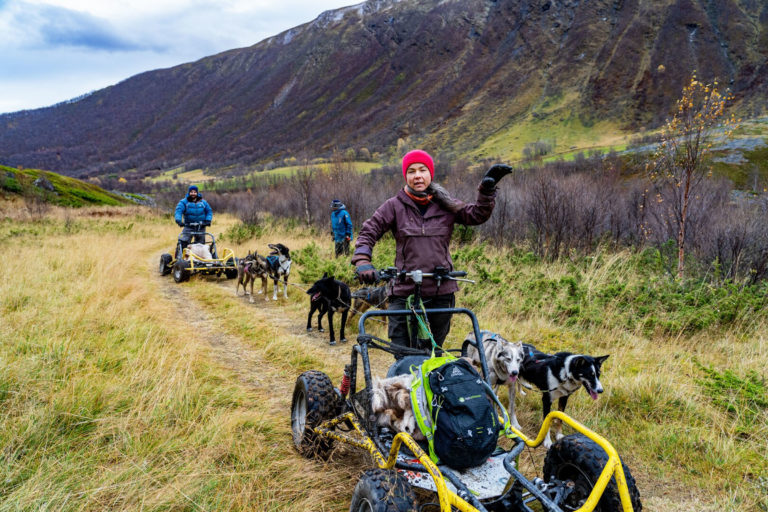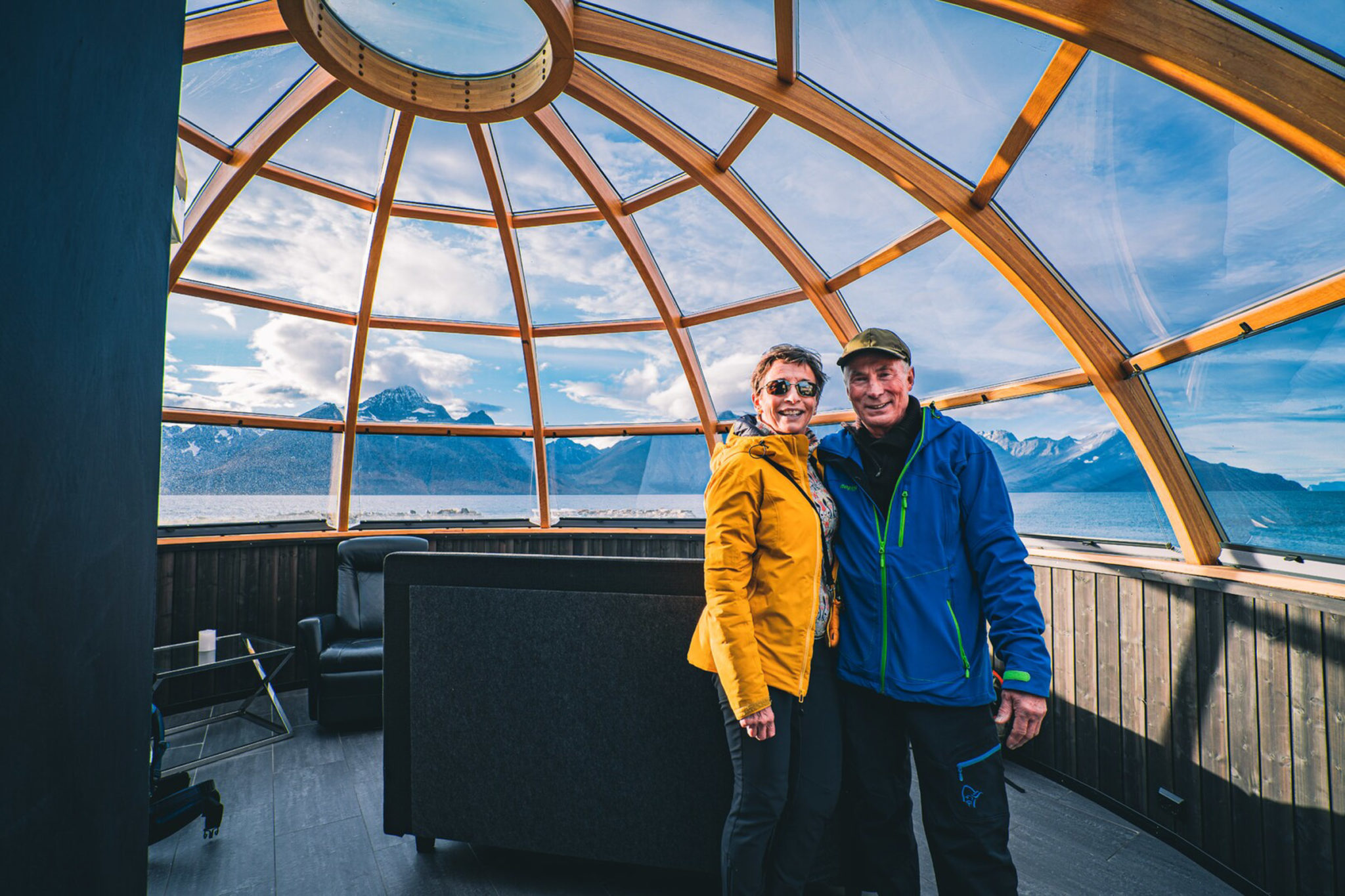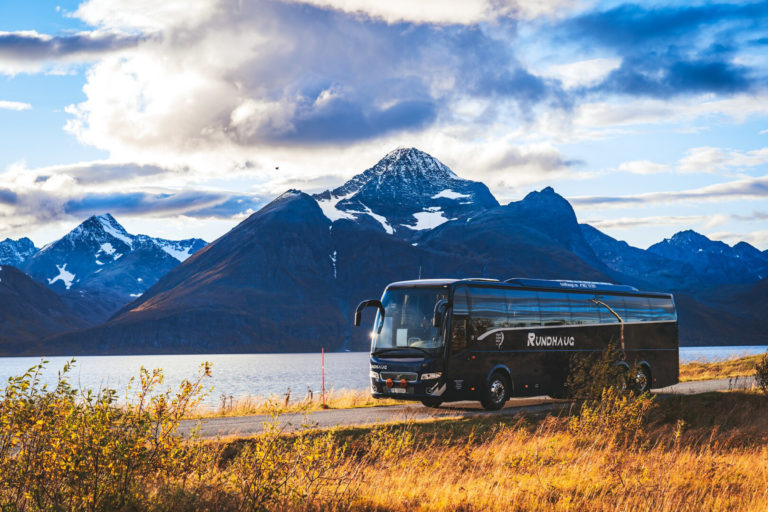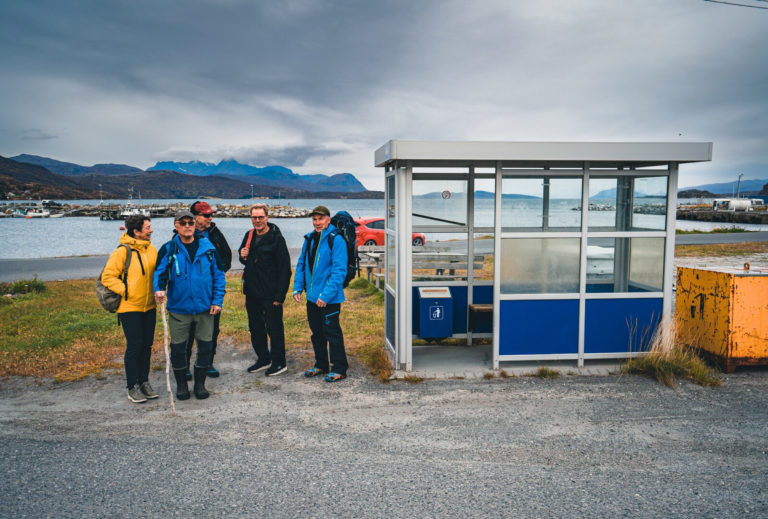The land behind the towering Lyngen Alps is full of stunnings landscapes, flaming colours and Northern Lights in Autumn .
Experience the awe-inspiring beauty of the Lyngenfjord, located between the northern end of Finland, the North Cape, and Tromsø. This majestic land boasts a range of towering mountains, sheltering blue fjords, mighty rivers, and small fjordside settlements sheltered from the fury of the Arctic Ocean by the majestic Lyngen Alps. With a multi-ethnic population of Sami, Kven, and Norwegian roots, the Lyngenfjord offers a unique cultural experience.
The Lyngen Alps reach towards the autumn sky
Rising up to 1833 metres from the Lyngenfjord the Lyngen Alps create a peninsula of pointed peaks, deep valleys, and gushing rivers. In the early autumn, the many small glaciers seem to hang like pale blue balconies among the dark, rock-hard cliffs and mountains. Whether you’re a seasoned mountain climber or prefer easier trails, there are beauty spots to suit all levels. Take a glacier hike and explore the stunning landscape, particularly attractive in the early autumn when this year’s snow is long gone. Make sure to do it with a guide, though.
Trails lead into the Lyngen Alps
An easy hike goes to the end of the peninsula, to Lyngstuva, a historic northern border of Norway, offering wonderful views of the cliff island of Nord-Fugløy. The hike to Blåisvatnet, the Blue Lake, is also not too challenging. The blue glacial waters of the lake, surrounded by ragged mountains and glaciers, have made it an Instagram favorite. The Lyngentrappa (Lyngen steps) in Lyngseidet give you instant fjord views by climbing a few hundred steps, or make that close to a thousand. More challenging is the hike to the Steindalsbreen glacier, melting into a little lake, but it’s doable for anyone with a moderate training program. Mount Jiekkevarri, the highest mountain in the high north, is best left to the most outdoorsy.
The eastern shores mountains and green valleys
The eastern shores of the Lyngenfjord offer the best view of the peaks. They are also penetrated by deep river valleys, with farmland and sub-arctic pine and birch forests. In the autumn, the vivid autumn colors dress the mountainsides for hundreds of meters up. At times, there is a sprinkle of powdered sugar on the mountaintops, heralding winter. The climate here is surprisingly dry and warm, and there are plenty of mountains of every size to hike.
Some trails come with a dramatic history
Trails come in all shapes east of the fjord too. The trail to the Jan Baalsrud cave is an easy forest walk to a place with a dramatic history. The Bollmannveien trail was built by Russian, Serbian, and Polish prisoners of war and leads high up the mountain. Strenuous at times, it’s technically easy. Drive to the end of the road in the Kåfjorddalen valley, and start the ascent to Halti (Finnish) or Halde (Sami), the highest mountain in Finland. It is actually much easier from here than from anywhere in Finland.
The Lavka trail is the ultimate bike ride
The Lavka trail is a full-day trip through the mountains. From the Kitdalen valley across the mountains to the Skibotndalen valley, you can follow a 68 km trail. It takes you through forested valleys and up the hillside to a maximum of 800 metres, way above the treeline, before descending past mountain lakes into the silent pine forests on the other side. Along the way, you can stop at old military installations from the end of WWII and the Cold War. It is strenuous, but you ride on old tractor tracks, and it’s not hard technically.
Head into the wilderness of the Reisadalen Valley
There is no valley like the Reisadalen Valley, though. Draining parts of the vast Finnmarksvidda plateau, the Reisa river meanders its way through forests under majestic cliffsides. The mode of transportation here are traditional, slender riverboats. These days, they are equipped with engines, traditionally one used to poke them. From the upper most farms in the valley, you can penetrate deep into the wilderness. The deep green of the pine, the sculptural black rocks and the flaming colours of the deciduous trees surround the river, it’s all fabulously silent and beautiful.
The Mollisfossen waterfall is an easy tour
269 metres, the Mollisfossen dives from the mountain plateaus in the east into the Reisadalen valley. When you arrive by boat on the big river, you walk for a few minutes through the forest, hearing the water before you see it. Then the water comes as a revelation, and if the sun shines rainbows form. Almost anyone can do a boat ride upriver, and the very outdoorsy of course hike further up the valley, notably to almost equally impressive Imofossen waterfall.
Magic points in Lyngenfjord
Some points you could include in an autumn stay in Lyngenfjord
Blåisvatnet – The Blue Lake
An intense blue colour and views to peaks and glaciers has made the Blue Lake into a famous observation point
Lyngseidet
Picturesque village with old houses and the church from 1770
Årøybukt – Aurora distillery
The world’s northernmost whisky distillery
Steindalsbreen glacier
A 2-3 hours hike takes you up to the glacier rising from a lake. NB! Glacier hikes with local guides only!
Skibotn
Sunny village with fjord views in the pine forest. Excellent for
The Lavka Trail
68 km offroad bike trail across the mountain. Surprisingly accessible, though…
Manndalen
Village with deep Sami roots and unique handicraft traditions
Kåfjorddalen – Gorsa waterfall
Bridge over monumental waterfall used for bungee jumping
Spåkenes
WWII fort and viewpoint to the whole range of the Lyngen Alps
Storslett
Centre of Nordreisa and starting point for the Reisadalen valley
Reisadalen valley
Take a boatride up to the 269 metre high waterfall of Mollisfossen
Skjervøy
Coastal town amid the islands
The outer coast faces the Atlantic
At the mouth of the big fjords, there is an archipelago of mountainous islands. Central in this northern and maritime area is the fishing town of Skjervøy, attractively surrounding a sheltered port. This is the place for a civilised cup of coffee before heading out to the islands with their steep coasts, minuscule settlements and wide seaviews.
From Engnes you see into eternity
There is an easy way to take in the grand coastal landscape around Skjervøy. The easy hike to Engnes takes you to the open sea, with an unobstructed view to the north. However, look to the left, and you see the mountainous islands rise directly from the open sea. The tour includes both WWII fortifications and sculptural cliffs. Or go to Stubbneset on the other side of town to look for the hidden treasure of the 17th c. local tycoon called “Skjervøykongen” – the Skjervøy King.
The Northern Lights mirror in the Lyngen Fjord
Some of the best Northern Light photos you’ve seen, come from the Lyngenfjord area. The dry, stable climate means there are often clear skies in Lyngenfjord. Thus, tourists from wetter Tromsø come to Lyngenfjord looking for the lights in the main winter season in December to March. However, in the autumn, far fewer tourists show up. But the first northern lights can appear already in mid-August. As the nights get longer, Aurora’s apparitions on the nights sky become more frequent. In mid-September, the evening hours with the best chances of spotting the lights are after dark. This means that the frequency is the same as in mid-winter. There is also increased activity in the atmosphere around autumn equinox, mirroring in lakes and rivers not yet frozen over.
How do you best see the Northern Lights in autumn?
Less visitors come for the Northern Lights in Autumn, meaning there are fewer organised tours on offer. However, the pleasant temperatures and the lack of snow means you can do your own thing on foot. Make sure you have a headlamp and a reflective to be seen by passing cars. The easy way of doing it is to walk around the village or settlements you’re staying in, maybe walk along the beach or on a quiet side road. A marked trail up the nearest hillside will be a little more strenuous but will also give you a wider view.
Being mobile increases your Northern Lights chances
If your area of the Lyngenfjord is cloudy, you could look at the weather chart and drive somewhere with clear skies. Southwesterlies to north westerlies will clog up the sky in coastal areas, with the the best chances for clear skies inland. Southeasterlies, on the other hand, will ensure the coast is clear. Literally.
The berry season is on
What do people talk about over coffee in Lyngenfjord at these times? The answer is simple, berries. In the latter half of August, the cloudberries ripen on bogs all around Lyngenfjord. So sought-after are these berries that there are restrictions on where to pick them. Blueberries are ripe at about the same time, and universally pickable. The crowberries have little taste but are harvested to make lemonade. Finally, in September, the tart, tasty lingonberries are picked in sunny, dry areas. Mushrooms are plentiful too, and since the locals are less knowledgeable about them, the mushroom-savvy can pick them everywhere.
There is more fun than hiking
The word “Lyngen” means “calm” in old Norse, and the calm waters on the fjord invite to kayaking. You can also go fishing, both the fjords and the open sea to the north are rich in marine life. On land, you can do dogsledding. Before the snow comes, the sleights have wheels. The dogs will be even happier than you to finally run again after hot (for them) and lazy summer. You can also try your luck at bungee jumping from the Gorsa bridge, with fabulous view to the Gorsa waterfall if you think clearly in that moment.
Lyngenfjord is where three peoples meet
Although Norwegian is spoken by nearly everyone in Lyngenfjord these days, the origin of the Lyngenfjord people is multi-cultural. The Sami culture is the oldest along the fjords. Norwegian settlement goes back to the Middle Ages. In the 18th C., immigration from Finland created the Kven minority. Despite heavy-handed assimilation efforts from the authorities, the Sami and Kven languages enjoy a revival in the small communities along the fjords and in the inland valleys.
Where do you spot Lyngenfjords heritage?
The exhibit “Møter” – Encounters – at the Halti centre in Storslett gives an overview of the history. The church at Skjervøy dates from 1728, and was part of a missionary effort in Sami areas. Almost as old is the one in Lyngseidet, from around 1770. The craft shop in Manndalen is consecrated to old Sami craftmanship. Look at the carpets that orginate thousands of years back and. The many small museums, like the Kven farm at Tørfoss, the Sami farm at Holmenes, the Norwegian farm at Gamslet and the market houses at Skibotn, are usually only open in summer. However, on your way around, they are picturesque photo stops from the outside.
In 1944, Lyngenfjord was on the frontline
Near the end of the war, the peaceful fjords, and islands in Lyngenfjord changed from peaceful backwater to the very frontline. The Nazi were withdrawing from the Kirkenes area to form a new front from the Finnish border to the inner Lyngenfjord, the so-called Lyngen Line. Slave labour built fortifications and roads, and the local population was forcibly evacuated from the entire eastern side of the Lyngenfjord. Suffering, death, and devastation came to the small communities the very last winter of WWII.
Where do you go to see the traces of war?
At Spåkenes, the Nazis built an enormous fortress, complete with cannons, concrete walls, and bunkers, with the help of slave labour. You can walk around the area, which also has a fabulous view towards the Lyngen Alps. Along the Lavkaløypa trail, there are WWII fortifications looking like iron age dwellings, because they were built without concrete in the winter of 44-45. Intrepid bikers can inspect them while crossing the mountain. You can also follow the tracks of the undercover allied soldier Jan Baalsrud through the Lyngenfjord area.
There’s whiskey on the fjord
Among the unexpected delights is the distillery Bivrost, found right under the Lyngen Alps near Lyngseidet. Here you can sample award-winning whisky brewed on barley from the area and water from the glaciers. Tours are on offer, also including WWII bunkers. Bivrost in Norse mythology is the name of the faint, unsteady bridge between the human world and the abode of the gods, often understood to be the Northern Lights. Of course, this is the northernmost whisky distillery in the world.
Where do you eat in Lyngenfjord?
Food to look out for in Lyngenfjord includes lyngenlam – Lyngen mutton, the surprising specialities of the Sea Sami kitchen and fish from the fjords, from the ocean in the north and from lakes and rivers. Since Lyngenfjord has no real cities, just small communities, things may not be open every day or all year. To sample high-quality cuisine, you can search for addresses like Solvind at Spåkenes, Koppangen brygger and the café at the Sami centre of Davvi álbmogiid guovddáš. Ask anyone from the area where to eat, and they’d recommend Bios in Storslett, serving up both comfort food and local specialities. If you get sleepy, Kaffekiin in Storslett will wake you up with their tasty coffee.
Some places to stay are just special
Utter luxury and exquisite relaxation can be had at Arctic Panorama Lodge. You can stay in a crystal Igloo at Green Gold of Norway or at Lyngen North at Spåkenes, super for watching the Northern Lights. Wide windows at Saraelv Wilderness Centre get you close to the forested landscape of the Reisadalen. At Solheim gård, you can stay at a farm, and Lauksletta is a little hostel on a remote island.
Do self-catering, or stay in a hotel
A mid-range budget can get you a nice holiday home, either a period home full of charm or a spacious modern and comfortable one. Some are suited for a couple, in others you can bring a group of friends or a family, and you can self-cater. There are also classic, mid-range hotels in Skibotn, Skjervøy and Storslett, with dining options. Hostels are places where the outdoorsy stay, exchange tips and socialise, usually at sensible prices.
How do you get to Lyngenfjord?
Lyngenfjord is, as an off the beaten track place, relatively easy to reach. It is found between the airports of Tromsø (TOS) and Alta (ALF). There is also a local airport in Sørkjosen (SOJ) with regular flights from Tromsø and Alta. From Tromsø and Alta there are daily bus connections to various parts of Lyngenfjord. The legendary shipping line Hurtigruten sails daily between Tromsø and Skjervøy, and there is also a catamaran connection, stopping at various points between Tromsø and Skjervøy. Check the travel planner of Troms County.
Combine with Tromsø
When the Lyngenfjord people want to eat well, watch concerts and theatre, and have a good time, they go to rowdy, merry Tromsø. When the Tromsø-ites want peace and quiet along with breathtaking scenery and outdoor fun, they go to Lyngenfjord, anything from glacier treks to berry picking. This proves that the Tromsø-Lyngenfjord combo is well tested. A few contemplative days in the Lyngenfjord area, with hiking in autumn scenery, some northern lights watching and lots of relaxation will be balanced out with sightseeing, culture, eating and drinking in the Arctic mini-metropolis. You can easily travel between the two, either by rental car or by public transport.
Finding your way around Lyngenfjord
Lyngenfjord is the traditional name for the Northern areas of the province of Troms, comprising the modern municipalities of Lyngen (centred at Lyngseidet), Storfjord (Hatteng), Kåfjord (Olderdalen), Nordreisa (Storslett) and Skjervøy. These municipalities have joined forces to inform visitors through Visit Lyngenfjord.
Visit Lyngenfjord has an excellent overview of accommodation in the Lyngenfjord area on their website. There are small hotels, lodges and self-catering options, but the big hotel chains have so far stayed away from Lyngenfjord.
There is a small airport in Sørkjosen (SOJ), with propeller aircraft connections to Tromsø and Alta. Otherwise Tromsø (TOS) and Alta (ALF) are the closest.
There are several buses a day from Tromsø’s main downtown terminal to various locations in Lyngenfjord. There is also a catamaran from Tromsø to Skjervøy, in Lyngenfjord’s northern areas. Check the website for public transport in Troms for the correct
The website of Visit Lyngenfjord is increadibly knowledgeable about the area, and definitely the first website to check.
